

A PUBLICATION OF BRUNICO COMMUNICATIONS LTD. CANADA POST AGREEMENT NUMBER 40050265 PRINTED IN CANADA USPS AFSM 100 Approved Polywrap SUMMER 2024 • $6.95 Dot-com déjà vu? Marketers grapple with FOBO ( Fear Of Better Options ) when it comes to artificial intelligence and the future of media ARE YOU READY FOR THE FUTURE? COMPUTER SAYS NO





Are you unleashing your brand’s full potential? Find out October 1, 2024 https://cmoforum.strategyonline.ca Thanks to our partners

There's an AI for that Resistance is futile, say experts as they encourage marketers to get their head out of the sand and into the future.
The industry in 2029
Marketing and media leaders convene to paint a picture of the mediascape over the next five years.
Timmies' diamond jubilee
The Canadian classic celebrates its 60th by doubling down on efforts to modernize its brand and business.
4 Editorial The future is calling • 8 Upfront Gen Z battles distorted views of their wallet, disillusions of the workplace and de-influencing trends. Plus, a call for Canada's airlines to buckle up and break boundaries, while brands duke it out on the culture scene • 56 Forum Fuse Create's Jon Crowley on why not to make the mistake of splitting strategy • 57 The 2024 Marketing Awards This year's winners' fate was revealed at a mystical gala • 58 Back Page A campaign coupon from Juniper Park\TBWA

ON THE COVER: History, hit repeat. Technofear began with the Industrial Revolution, when it became a capital offence to destroy machines after violence skyrocketed over concerns of job loss. People also refused electricity for fear of being fried in their beds. Computerphobia was common in the '80s and the internet brought fresh apocalyptic fears in the 2000s. New tech has always frightened humans, even though we are its makers. But we adjust, we embrace and we forge ahead. There's no getting the AI train off its tracks. Question is, are marketers prepared for full steam ahead?
THE A-LIST
A look at the shops that are proving innovation and creativity are imperative to building brand equity.
SUPPLEMENT Page 23

PUBLICATION COMMUNICATIONS LTD. CANADA NUMBER CANADA Polywrap $6.95 Dot-com déjà vu? Marketers grapple with FOBO Fear Of Better Options) when it comes to artificial intelligence and the future of media ARE YOU READY FOR THE FUTURE? COMPUTER SAYS NO
3 Summer 2024
16 48 10
SPONSORED SUPPLEMENT 41 Agencies across Canada are undergoing transformative journeys, redefining how we think about the client-agency relationship. Whether it's shifting towards creative consultancies, adding new capabilities or expanding regionally or globally, our A Listers are aggressively adapting to changing market dynamics. They’re ensuring that their shops remain agile and innovative, poised to better navigate the ever-changing marketing landscape and meet the evolving needs of clients and consumers alike. How are they doing that? Well, there’s no one-size-fits-all solution. Read on to find out more. SUMMER 2024 VOLUME
35, ISSUE 3
Avid crewneck and dad hat collectors rejoice at the launch of a commemorative Tims clothing line.
Change is hard, messy, and necessary
My amygdala – hardwired to perceive change as a threat – was on fire after I gave birth to my son. I’ve made it no secret that it took a long time for my brain to catch up to my new reality. I resisted the transition with every thread of my being. And I discovered that the pain of loss can, in the moment, seem greater than the power of gain. So in a very personal way, I get why a lot of people are angsty about the future.
Humans have a track record of resisting change. Writing was shunned by philosopher Socrates who believed it would lead to forgetfulness. Electricity terrified U.S. President Benjamin Harrison who delegated light switching to White House staffers as he feared being electrocuted. Computers brought new hostilities. And the act of juggling work emails was studied by British researchers and believed to have the same negative impact on a person’s IQ as smoking pot. (OK, some days that one feels legit.)

WHILE I DONT SUFFER FROM FOBO (THE FEAR OF BETTER OPTIONS OR BECOMING OBSOLETE), I DO WISH AI CHATS DIDN'T FEEL LIKE THROWING TRASH IN THE OCEAN WITH ITS INSANE USE OF ENERGY.
We will always long for simpler times. And we will always want to be in control. But nothing about the progress of artificial intelligence – which Sam Altman himself admits OpenAI doesn't fully understand how it works – is not simple nor is it under our control. But I've read enough headlines, listened to enough podcasts, sat in enough conferences, and spoken with enough experts to know that we won't be able to escape the AI boom any more than we did the dot-com bubble.
Marketers, in particular, appear to be slow to adopt the tech for myriad reasons (beyond fear), which we explore on p.10. One of those reasons is that it's just so bloody complicated and there's just so much to digest. But when I spoke with Mastercard's CMO Raja Rajamannar at the WFA Conference in May, he made a good point. How many hours do we spend aimlessly scrolling social when we could be investing that time with "experiential learning"?
For this issue, I took his advice. I poured myself into Gen AI tools. Not necessary to come up with net-new ideas, but to help shape original ideas for content, and even the cover. (We ultimately chose not to use any images Dall-E 3 spat out during our cover trials, but there were teachable moments.) I quickly came to think of ChatGPT as my editorial side-kick. It's simplified jargon-filled press releases for me, and it's been a sounding board for assignments. That said, while I dont suffer from FOBO (the fear of better options or becoming obsolete), I do wish AI chats didn't feel like throwing trash in the ocean with its insane use of energy. So if someone could figure out how to harness nuclear fusion to feed AI's energy appetite, that would be swell. In the meantime, happy experimenting!
Jennifer Horn, Content Director, Editor, strategy
spring 2024 volume 35, issue 3 strategyonline.ca
publisher | lisa faktor | lfaktor@brunico.com
content director, editor | jennifer horn | jhorn@brunico.com
art director | tim davin | tdavin@brunico.com
associate publisher | neil ewen | newen@brunico.com
strategydaily editor | andrew jeffrey | ajeffrey@brunico.com
media in canada editor | greg hudson | ghudson@brunico.com
senior reporter | chris lombardo | clombardo@brunico.com
reporter | andrea hernandez | ahernandez@brunico.com
contributors | will novosedlik, brendan christie
account manager | conidon pinto | cpinto@brunico.com
account manager | nupur purohit | npurohit@brunico.com
marketing co-ordinator | emily yuill | eyuill@brunico.com
program co-ordinator | mahalet mengistu | mmengistu@brunico.com
CORPORATE
president & ceo | russell goldstein | rgoldstein@brunico.com
evp, editorial director | mary maddever | mmaddever@brunico.com
director, finance & administration | michelle plaskon | mplaskon@brunico.com
creative services & dist. manager | adriana ortiz | aortiz@brunico.com
customer support supervisor | christine mcnalley | cmcnalley@brunico.com
how to reach us
Strategy, 366 Adelaide Street West, Suite 100, Toronto, Ontario, Canada M5V 1R9 Tel: (416) 408-2300 or 1-888-BRUNICO (1-888-278-6426) Fax: (416) 408-0870 www.strategyonline.ca
customer care
To order a subscription, visit strategyonline.ca/subscribe. To make a change to an existing subscription, please contact us by email: strategycustomercare@brunico.com.
Tel: (416) 408-2448 Fax: (416) 408-0249. 8799 Highway 89, Alliston, ON L9R 1V1.
subscription rates
STRATEGY is published five times per year by Brunico Communications Ltd. In Canada: One year CA$80.00 Two years CA $144.00 (HST included. Registration #856051396 RT) Single copy price in Canada is CA$6.95. Please allow four weeks for new subscriptions and address changes.
copyright and trademark
STRATEGY and the tagline “Bold vision brand new ideas” are trademarks of Brunico Communications Ltd. All rights reserved. Nothing may be reproduced from STRATEGY in whole or in part without written permission. Reprint requests should be sent to rgoldstein@brunico.com. © 2018 Brunico Communications Ltd.
postmaster notification
Canadian Postmaster, send undeliverables and address changes to: Strategy, 8799 Highway 89, Alliston, ON L9R 1V1 strategycustomercare@brunico.com U.S. Postmaster, send undeliverables and address changes to: Strategy PO BOX 1103 Niagara Falls NY 14304 Printed in Canada. Canada Post Agreement No. 40050265. ISSN: 1187-4309.
Member of
4 strategyonline.ca
EDITOR’S NOTE


https://mediaincanada.com/subscribe/




All the media news you need. Replenish daily. Sign up for your free trial and stay connected with all the change afoot across the Canadian media scene.

It’s not new news that we’re facing lightening speed transformation. Traditional roles are once again being upended, pushing us to think outside the box.
However, this time around we’re seeing that the fragmentation of media has fundamentally altered the landscape. We no longer rely on a handful of channels to deliver a unified message that reaches a mass audience. Instead we are navigating a myriad of platforms across linear and digital. While each demands a tailored approach, the challenge facing the marketing community is maintaining a cohesive brand narrative, while also preserving valuable, trusted media sources.
Yet, this fragmentation also presents an opportunity to rethink how we are reaching consumers. Is the message really lost in the medium, or do we need to re-evaluate how we’re sharing the message?
We recently sat down with brand and media agency heads for our annual Media Roundtable Dinner Series to find answers and discuss the issues impacting marketers and the media ecosystem. We cover what the future of media holds from spend trends to safeguarding trusted media, talent investment and the use of artificial intelligence on page 16. While the tools and platforms we leverage may evolve, the core principles of effective communication remain steadfast.
In response to pressures, agencies are undergoing their
PUBLISHER’S NOTE
The future of media (and a birthday celebration)
own transformations. They are retooling, and some are even becoming strategic consultants and integral business partners. This shift is crucial as marketers seek partners who understand the broader business context and can offer insights that drive not only marketing success, but overall business growth.
This year’s Agency A-Listers are living up to these expectations (see p. 23). They are investing in new data analytics, consumer insights, and cutting-edge tech to stay ahead of the curve. They're embracing a more holistic approach, integrating creative excellence with strategic acumen. This evolution positions them to provide the guidance and partnership brands look to them for.
And as we talk about transformation, strategy is no stranger to change. As we head into our 35th year, we have plans and celebrations that are set to roll out this summer and fall. Keep your eyes peeled to Strategyonline.ca in the coming weeks as we unveil our new look and series from the archives, sharing highlights from three-and-half decades of unparalleled coverage. (If you have stories from over the years, we’d love to hear those too.) We’ll be celebrating this milestone in person at our annual Agency of the Year gala, so mark October 30th in your calendars.
We’ve also just announced the launch of the 2024 Media Innovation Awards. We’ve added
WE ARE NAVIGATING A MYRIAD OF PLATFORMS ACROSS LINEAR AND DIGITAL. THE CHALLENGE FACING THE MARKETING COMMUNITY IS MAINTAINING A COHESIVE BRAND NARRATIVE, WHILE ALSO PRESERVING VALUABLE, TRUSTED MEDIA SOURCES.
some important new categories this year, like the Best Use of Local Media, Best Collaboration and Media Agency Innovation, which looks at the new thinking and evolving strengths across Canada’s media agencies. Make sure to share your plans and media thinking that highlight the immense talent across this country before August 16.
On the conference side, our CMO Forum returns October 1 and will dive into the evolving role of the CMO and how marketers are responding to the pressing challenges they’re facing today. It’s a full day of learning and high-level networking, followed by the Strategy Awards that celebrate the strategic plans and blueprints of successful brands.
So as we look to the future, it’s clear the industry will continue to evolve. While the specific challenges may differ, the need for innovation, strategic thinking, and strong partnerships remains constant. And we’re here for all of that.
Enjoy the sunshine and slowdown this summer.
Cheers,
Lisa Faktor, publisher, strategy
6 strategyonline.ca
Celebrating the 2024 Canadian Cannes Lions Jurors

ALLARD-GENDRON Creative Director, Sid Lee



SHELLEY BROWN Chief Strategy Officer, FCB Canada


Partner, Chief Creative Officer, Angry Butterfly



ANDREA OGUNBADEJO VP, Managing DirectorProduction, Cossette


JENN DUGGAN President, Ontario & West, Canada, Citizen Relations


RYAN CROUCHMAN Partner, VP, ECD Design, LG2
The Cannes Lions International Festival of Creativity is the largest gathering in the creative community and where the Cannes Lions Awards are announced.
I would like to offer my sincere congratulations to the Canadians who have been named to the 2024 Cannes Lions juries.
As the most recognized and prestigious marketing and advertising awards in the world, the selection of these jurors reaffirms the talent and expertise within the Canadian marketplace.

On behalf of the Canadian advertising industry, congratulations to the leaders named to this year’s Cannes Lions Awarding and Shortlist Juries.
Canadian Cannes Lions Advisory Board Members
The Canadian Cannes Advisory Board is a steering committee that provides strategic insights and supports the Cannes Lions mission in the Canadian marketplace. Comprised of leaders across media, marketing and industry, the Board’s objective is to champion the value of creativity and amplify Canadian talent and work on the global stage. A special thank you for their expertise and dedication.

CARRENO President, Interactive Advertising Bureau of Canada

IRVING Chief Marketing Officer, Kruger Products Inc.

LEWIS President, Canadian Media Directors’ Council

OMD Canada

HOWE President, The Township Group

MADDEVER EVP, Realscreen & strategy and Editorial Director, Brunico Communications


Managing Director, Client Partnerships and Commercial Operations, The Globe and Mail


Cannes
Cannes Lions Shortlist Jurors
Andrew Saunders President and CEO, The Globe and Mail Chair, Canadian Cannes Lions Advisory Board
Lions Awarding Jurors
AUDIO & RADIO
HEALTH & WELLNESS
YUNG
CRAFT
Canada SOCIAL & INFLUENCER STEVE PERSICO
OUTDOOR RAFIK BELMESK
CREATIVE STRATEGY ERIN KAWALECKI
CREATIVE COMMERCE
PUBLIC RELATIONS
DIRECT ISABELLE
PRINT & PUBLISHING
JANE MOTZ HAYES Chief Creative and Design Officer, Havas Health & You PHARMA Mike Dubrick Chief Creative Officer, Rethink
MARTY MARTINEZ Chief Creative Officer, TANK Worldwide
STEPHANIE
Chief Design Officer, Zulu Alpha Kilo INDUSTRY
GLEN D’SOUZA Head of Creative, Forsman & Bodenfors
Chief Creative Officer, Leo Burnett Toronto
Chief Strategy Officer, Dentsu Creative
FILM CRAFT
DESIGN
SONIA
CATHY COLLIER Chief Executive Officer,
LUC DU SAULT Partner, VP, Executive Creative Director, LG2
SUSAN
KAREN
PENNY HICKS
SHANNON
MARY
DOMINIQUE VILLENEUVE President and CEO, A2C
The Globe and Mail is proud to be the official Festival representative in Canada for the Cannes Lions International Festival of Creativity. CANADIAN PROGRAM PARTNERS YOUNG LIONS SPONSOR

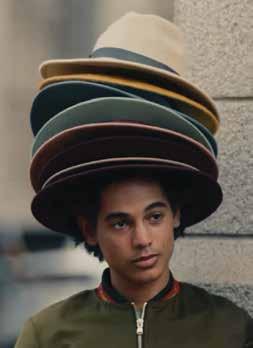
TRENDS
GETTING TO KNOW GEN Z
By Andrew Jeffrey
INNOVATION
FLIGHT CLUB
By Christopher Lombardo
When commercial flights took off in the ’50s, everyone was treated like royalty, with free meals, spacious seats and first-class service. While the golden age of flying will likely never return, at least Air Canada passengers can dine on free wine, beer and snacks – but only this summer. The company announced the change in June, with Porter slapping back on social, reminding Canadians that it’s been offering the same perks for decades. “What’s next, a raccoon mascot?” the brand quipped.
Strategy chats with Johanna Faigelman, founding partner and CEO of Human Branding, to understand three online trends affecting Gen Z.
DE-INFLUENCING
The bloom is off the rose for influencer marketing in 2024. “De-influencing” drives Gen Z towards more mindful consumption and against buying unethical or indulgent products. It’s a rejection of how Gen Z is encouraged to make impulse decisions by social influencers. “Think of it as a cleanse for your body,” Faigelman says. “A lot of Gen Z is realizing they have to do a cleanse of influencer culture and get it out of their system, then get back to a more authentic, tactile, trustworthy place.” Faigelman notes that, along with being more honest, brands should only use spokespeople who have a direct connection to their product. It dovetails with a larger trend towards wanting to connect in real life, which Faigelman says should encourage marketers to reconsider in-person marketing tactics to capture the word-of-mouth that made influencer marketing novel in the first place.
MONEY DYSMORPHIA
As online images of opulent luxury collide with the realities of an economic downturn, young people are reporting that they feel “money dysmorphia.” The relatively new trend refers to feeling insecure about your financial situation, even when your reality raises little cause for concern. Faigelman connects this with aspirational images of celebrities on social media, juxtaposed against stress about personal finances.
“There’s a huge psychological dimension to money, and that’s where money dysmorphia comes from. It’s marked with feelings of shame, guilt, aspiration and anxiety,” Faigelman says. “Things like the pandemic, housing crisis and recession are attacking our feelings of emotional security.” Because of this, notions of security, comfort and transparency are more effective in marketing to Gen Z than lavish lifestyles and aspirational messaging. People are cautious about spending, and so she suggests brands support mindful consumption and offer transparent pricing. She adds that some brands, like financial institutions, could respond by highlighting financial literacy, offering expertise on how to save and spend wisely.
QUIET QUITTING
When “quiet quitting” blew up as a trend in 2022, it was all about setting boundaries and doing the minimum amount of work. Now, it exists in tension with money dysmorphia, as many young people feel they need to work more to get ahead in a shakier economy. Quiet quitting is part of changing workplace attitudes for Gen Z, and is pushing companies to prioritize employee well-being rather than company loyalty and traditional notions of career advancement. “How are you going to be able to speak the language of this generation, which is engaged in a realization that we don’t want to be pushed beyond what’s reasonable?” Faigelman says. “I think there’s ways brands can recognize that, and speak to the notion of de-stressing, not burning out.”
According to McGill University’s John Gradek, an expert in aviation management, when it comes to in-flight innovation, North American airlines are “not in the same ballpark” as global players. Air New Zealand, for example, is installing sleeping pods and

seats that turn into couches. China Airlines, meanwhile, is teaming up with Michelin-star resto Mipon to serve curated dishes – for everyone, regardless of class.
Gradek advocates airlines adopt a “back to basics” approach, with a fare raised by a reasonable amount – a suggestion that flies in the face of WestJet’s new UltraBasic no-frills, low-cost fare that doesn’t permit carry-on baggage and other norms. News outlets have reported on an “online roasting” of WestJet by Canadians who question what they’re actually getting from the fare. Peter Drummond, cofounder and strategist of brand consultancy PSD+G Strategy Group, says the race to offer lower fares (and nothing else) will only run counter to building brand equity.
8 strategyonline.ca
Above: Air New Zealand plans to install bunk beds in its planes.
WHO DROPPED IT BEST?
Strategy asked Travis Cowdy and Lyranda Martin-Evans of Fellow Human Creative to deconstruct recent culture-tapping “drops” – giving each a score to determine the brand beauties and busts.
Hellmann’s vs. Tim Hortons
Both brands created kicks with a quirky bent: Hellmann’s “1352” sneakers were made entirely from $1,352 worth of food waste – the average amount Canadians leave on their plates each year, and a tie to the brand’s mission to divert food from landfills. Meanwhile, a Tim Horton’s and Adidas collab led to the creation of four anniversary sneakers that give a nod to the QSR’s donuts

COWDY: With rising grocery prices all over news headlines, food waste is definitely top-of-mind for consumers, and Hellmann’s certainly found an interesting way to deliver a stat. Getting from food waste to shoes is a bit of a leap, but it is an interesting way into a timely issue. Also, props on the design. I think they’re ugly as all hell but that probably means they’re cool. I’m a 40-something dad, what do I know about fashion?
MARTIN-EVANS: Would a consumer buy these? That’s probably not the point, but the story behind them makes for a nice PR play. I’m always in awe of how agencies make stuff like this happen. “Make a shoe with scraps!” Where do you even start? Impressive. Although the colours and logo help with branding, it is asking the consumer to draw a lot of lines back to mayonnaise, adding it to leftovers and not wasting food. But this idea has a lot of sole.

COWDY: The Tim’s shoe feels like a third round creative idea where the client wasn’t buying what was being served. Changing some colours on a popular shoe design and calling it exclusive... I’m sure they had better stuff.
MARTIN-EVANS: I feel that people would buy these. Fans like owning a piece of culture and they love Tim’s. But there are only four to be had. The design needs a bit of Tim’s brand magic for me. I like the sprinkle one and how it adds some whimsy and donut-ness (like how the Nike bagel shoes had sesame seeds). So I guess I’m craving a sprinkle more of Timmie’s. And some double-double socks.
McDonald’s vs. BMO
Who doesn’t love a rap track about burgers and, er, bills? McDonald’s teamed up with rapper Lil Tachty to remix its O.G. 1989 Menu Song in an effort to promote its Remix Menu. Over at BMO, rapper bbno$ created a track to relay the brand’s mission to support youth financial literacy.

COWDY: This is a classic case of risk-taking vs de-risking. McDonald’s took the latter route. Take something iconic from 30 years ago and add a current celebrity. Hollywood has been doing it for the past two decades. It’s a classic cheeseburger. It’s nostalgic and it’s comfortable. It certainly doesn’t disappoint, but it’s not exciting or new.
MARTIN-EVANS: Brings me back to the “Big Mac McDLT” menu song I grew up with (and can still recite). I super dig this! It’s all product, and all vibes. I think music is more interesting when it’s re-imagined with a new singer and ukulele. Consumers will bite into it, too. More like this please!

COWDY: BMO went out on a limb and created something unexpected for a bank. Taking the trope of rappers boasting about excessive spending and flipping it to fiscal responsibility is hilarious. The track slaps and the film is well executed. I only wish they had the guts to run this in mass channels. Gen X parents like me grew up on rap and I’d certainly pay more attention to this than most other bank spots in the market.
MARTIN-EVANS: Nailed it. The rapper they chose, the target, the way they launched it. The video is hilarious and the song is a bop. Bills paid on tiiiiime! I’m singing it now. Thanks for making a boring thing fun. More banks should be fun. And not just for a younger age demo. Please sing about tax deferral strategies and RESPs next. Thaaaaaanks!
By Jennifer Horn
UPFRONT CULTURE
WARS
9 Summer 2024
FUTURE SHOCK
DESPITE RECOGNIZING AI’S POTENTIAL, MARKETERS ARE HESITANT TO ADOPT IT DUE TO ORGANIZATION

AL CHALLENGES AND SKILLS GAPS, EXACERBATED BY JOB LOSS FEARS AND LACK OF UNDERSTANDING.
SHOCK
By Will Novosedlik
While marketing has been rocked by one technological change after another over the last 25 years, nothing appears to be so radical as the promise of artificial intelligence. That said, marketers appear to be struggling when it comes to balancing the competing demands of the CEO’s AI strategy, the relentless pace of product development in the space, a deluge of hype and – lest we forget – the daily pressures of meeting quarterly forecasts.
As a consequence, there exists a major gap between the belief in AI as a panacea for the future, and marketers taking action to bring the technology to their teams.
In a recent study by Plus Company and Statista, 75% of marketers agreed that AI adoption was critical to the future of their field; 75% agreed that AI’s learning capabilities provide profound insights into customer behaviour and preferences; 69% agreed that AI-driven insights assist in optimizing spend across channels; and 66% agreed that AI helps anticipate and mitigate risks by modeling potential outcomes.
Yet, 75% of them have not taken any steps to adopt AI.
To be fair, a recent article by Goodmans LLP pointed out that firms with 100 or more employees are more likely to adopt AI, with a 20% adoption rate in Canada. But that still means 80% are laggards. Why is this the case?
Goodmans claims the main obstacle – cited by 69% of Canadian businesses currently not using AI technology
– is the challenge of identifying a business case for AI. Additionally, 28% reported being unaware of available AI tools. For firms already in the AI marketplace, the cost of technologies and skills gaps in their workforces were identified as the primary barriers to adoption.
When it comes to marketers, specifically, there are other barriers to consider.
“I think the first major issue is organizational,” Raja Rajamannar, chief marketing and communications officer, as well as founding president of the healthcare business at Mastercard, tells strategy. “Since AI is a technology, the CEO immediately claims it as his or her territory. Classical marketers, particularly those who have reached CMO level over the last 20 to 30 years, tend to be more qualitative. They focus on psychology, sociology, anthropology, design, brand positioning – all the finer aspects of marketing. They are a little scared of data, technology and numbers, which includes finances. As a result, they naturally do not gravitate toward technology. Additionally, someone else (such as the CTO) claims the domain of technology, which further deters them from embracing it.
“Number two, there have been early incidents where companies using Gen AI had their data become public. Consequently, many companies clamped down, allowing AI use only on personal devices for hobbies, not for company work, due to confidentiality concerns.
11 Summer 2024
“Number three, AI is fundamentally complex. You have machine learning, deep learning, neural learning and different types of AI like Artificial Narrow Intelligence, Artificial General Intelligence and Artificial Super Intelligence. There’s a distant awareness of AI, but its exact workings are unclear, especially in the marketing community, which is not tech-driven,” he concludes. But perhaps the greatest hesitation is the threat of job loss.
With all the recent news about Starbucks, McDonald’s, Etsy, Walgreen’s, UPS, Lowe’s, Johnson & Johnson, Uber and Lyft eliminating the CMO role at their respective companies, you can understand a CMO’s fears.
“Classical marketers tend to be more qualitative. They focus on psychology, sociology, anthropology, design, brand positioning — all the finer aspects of marketing.”

- Raja Rajamannar, CMO, Mastercard
In March 2023, Goldman published a report suggesting that AI could replace the equivalent of 300 million jobs. A recent CNBC Workforce survey revealed that 51% of people in advertising and marketing and 46% of people in business logistics and support worry that AI will take their jobs.
But Rajamannar strongly encourages the industry to push aside their fears and embrace change in the age of AI. “Tools like ChatGPT single-handedly made AI accessible. Marketers started playing with it, asking it to write poems or press releases, and saw its potential. But this also created a sharp divide: some CMOs see it as an unprecedented empowering tool, while others fear their jobs might be taken away.
“Overall, this situation will likely sort itself out quickly. Historically, new technologies take years to settle, but I predict most companies will adopt AI in less than two years due to its cost-efficiency and empowering nature. AI augments intelligence rather than substituting it.”
Who’s adopting AI – and how?
Over the last year, strategy approached several Canadian marketing heads to discuss their use of AI. Almost all denied or ignored requests for interviews, except TD’s Tyrrell Schmidt, who shared some thoughts
over email. She says TD’s approach to implementing AI has been cautious, which makes sense given the banking world’s unique challenges when it comes to transparency and security.
“Our customers expect us to have their best interests at heart as we adopt new technologies,” says the CMO. “We are focused on maturing our AI capabilities, talent pipeline and technology infrastructure in a transparent and trustworthy manner.
“Currently, the bank is using AI to forecast customer behaviour and market trends… For content creation we’re leveraging marketing-leading tools and capabilities to optimize and test more personalized creative for marketing interactions. And for customer experience, we’re using AI models to help us understand sentiment and emotion through customer feedback channels.
“Gen AI is something that we’re working our way into, with a lot of important considerations for our customers and our organization. We do see tremendous opportunities, especially in areas like digital marketing and creative,” adds Schmidt.
One key thing to remember in the adoption of artificial intelligence is that it is not plug and play.
“There’s a lack of awareness about embedding AI capabilities into a company. It involves organizing data, training the AI engine for your specific context and maintaining confidentiality,” says Rajamannar. IBM’s Intelligent Marketing global lead, Alexis Zamkow, agrees: “You can’t just turn on one of these models and expect it to speak in your brand voice and understand tone, values, personas, products and your legal mandatories.
“When it comes to brand compliant communications, there is an enormous amount of tuning and training that has to happen so that the model can reflect the brand. And that means you have to pull in all the brand standards,” adds Zamkow. “You’ve got to digitize them, you’ve got to tune the model, and then you’ve got to train the model with images and text together. So there’s training around the structure, there’s training around the basic capabilities and the understanding of the brand.”
WPP’s chief technology officer, Stephan Pretorius, says some tend to over-estimate AI’s possibilities without thinking through not only the technical and short-term limitations – but also what kind of future business environment they want to create.
“We did two things at the same time [when creating WPP’s Open AI platform]: create a safe, secure environment… and then examine potential use cases across the entire supply chain of our offering – from strategy to brand consulting, to creative ideation, development, production, media buying, planning, activation, experience management, CRM commerce and PR,” says Pretorius.
12 strategyonline.ca
The WPP team found that all of the use cases fall under three categories: ideation, automation or optimization. “Ideation is about where you are using AI to come up with more ideas, better ideas, more informed by market research and more informed by different perspectives – a lot faster. You can test concepts, you can you ideate new ways of thinking about or visualizing a product,” says Pretorius.
Then there’s automation, which is about “taking the humans out of existing marketing processes or eliminating steps altogether.”
Rajamannar shares Mastercard’s own use of AI for automation, pointing to the company’s team in Singapore, which developed a B2B generative AI tool (currently being rolled out globally) to shorten the response time for RFPs – a time-consuming process that ties up organizational resources. “An RFP that used to take seven weeks now takes a few hours,” says Rajamannar.
Another example of automation would be the ability to develop campaign creative into dozens of different formats and languages, that looked like it was filmed in different locations, says Zamkow. “This is the labour intensive work where the savings are going to happen, but you need to have your model properly trained before you can get to that derivative content development.”

Anthropic
The company’s chatbot finally landed in Canada this June after more than 100 countries got a chance to test it first. Similar to OpenAI’s ChatGPT –but with a deeper focus on researching and developing AI safety – the platform is designed to generate human-like text and assist users in various tasks. Marketers can use it to streamline workflow by creating blog posts and articles, social content, ad copy, conduct market research and trend analysis, as well as campaign analysis, from interpreting data to A/B testing.
“When it comes to brand compliant communications, there is an enormous amount of tuning and training that has to happen so that the model can reflect the brand.”

As for optimization, this is where you get the biggest bang for your buck. An example would be WPP’s Performance Brain, which basically looks at a hundred visual elements in any marketing content (such as video or static ads), links them to campaign metrics (like brand lift studies or conversion reports) and then builds a
A
marketer’s guide to Gen AI
To get teams up to speed on all things AI, Mastercard’s Raja Rajamannar recommends creating a committee to oversee initiatives and ensure safety and compliance; introduce AI training classes for all marketing staff, covering everything from the basics to advanced applications; as well as identifying tech-savvy early adopters on the team and sharing a newsletter to keep everyone updated on today’s tsunami of tools – starting with the apps and platforms below.
Adobe Sensei GenAI
This platform uses advanced AI models to create and edit text in things like email marketing. A clothing brand, for example, will gather data on its customers (purchase history, browsing behaviour and the like). This data is then fed into the Adobe Experience Platform, where it is used to train Sensei to understand the brand’s customers. For example, the AI learns that Customer A likes sportswear and Customer B prefers formal wear – and is then able to create custom email content for each.
Google Gemini Chatbot
A marketer can use this tool to improve interactions their brand has with customers. For instance, the chatbot can answer common questions 24/7 – such as inquiries about products, prices and shipping, freeing up human agents for more complex tasks. It can also make product suggestions, as well as share special offers and upcoming sales. After a purchase or interaction, the chatbot can even ask customers for feedback.
Microsoft Copilot
Microsoft recently revealed a new AI-powered Copilot for its Microsoft 365 apps and services, designed to assist people with generating documents, emails, presentations and much more. The Copilot (powered by GPT-4 from OpenAI) will sit alongside Microsoft 365 apps much like an assistant. Remember Clippy? This is Clippy on steroids.
13 Summer 2024
- Johanna Faigelman, founder and CEO, Human Branding - Tyrrell Schmidt, CMO, TD
prediction model to show how the new ads will perform.
“The optimization cases are already very clear,” adds Jason Dubroy, founder of strategy consulting firm The Commercery. “From retail media planning to predictive analytics, or from brief writing to copy prompts, brands and agencies are identifying or manufacturing opportunities to make, save or invest their scarce dollars. The key won’t be if AI can be trusted, it will be how it can be trained to know that it’s right.”
To Pretorius’ areas of ideation, automation and optimization, Dubroy adds a fourth: personalization.
“This is the most prominent immediate next use of this tech, democratizing data analysis and making it more accessible. However, it is essential to remember that in its current state, AI has limitations and is uniquely fallible, even if many people believe that it’s not.”
- Mitch Joel, founder, Six Pixels Group
“Ideation is where you are using AI to come up with more ideas, better ideas, more informed by market research and more informed by different perspectives - a lot faster.”

He cites successful examples including Nike’s “By You” campaign, which uses AI to allow customers to design their own shoes; Coca-Cola’s “Create Real Magic” campaign, which implemented an AIpowered web app that invited digital artists to create artworks using AI tools; and Sephora’s Visual Artist, where a person can try on different products virtually, using AI to match skin tones with the perfect foundation shade.
For marketers who are not quite sure where to start when it comes to adopting the emerging tech, Rajamannar has this advice: “First, invest a few hours learning about AI – not the technical aspects, but the scope of its applications… There are many ways to train yourself, but one free training program is Generative AI for Executives by Shelly Palmer. It’s simple, easy to understand, and covers the basics.
“Understand what goes on behind-the-scenes to ask intelligent questions and assess the answers. Every vendor today claims their solution is powered by AI. Ask them to explain exactly how, and you’ll often find a lack of substance. CMOs need to educate themselves to leverage AI smartly. If they treat it as a black box, they risk garbage in, garbage out situations. The key is to understand enough to use AI effectively.”

Search is dead. Long live the chatbot.
Soon, you will notice something different at the top of your Google search results pages. “AI Overviews” are already being tested in the US, but the company plans to expand to other countries by the end of 2024. When you use Google Search, a box of AI-generated text will appear at the top of the search results, with links to external websites. Traditional search results will appear below the AI Overviews.
In a blog post from Google VP Liz Reid, AI Overviews results are generated using the company’s large language model (LLM), Gemini, and are designed for instances when someone wants to “get both a quick overview of a topic and links to learn more.”
But observers say it is far more grave than that. According to Scott Rosenberg, managing editor at tech journal AXIOS, Google’s shift toward AI-generated search results, displacing the familiar list of links, is “rewiring” the internet — and could accelerate the decline of the World Wide Web.
Gartner VP Alan Antin predicts a 25% decline in search traffic by 2026 due to AI chatbots, which could lead to a decrease in the importance of web pages. This prediction is based on Gartner’s observation that more and more people are using chatbots like ChatGPT to answer questions they would have normally done with search.
Rosenberg says that the search engine still relies on web-based information, but it doesn’t reward the creators of that information with users’ visits. Publishers and retailers are terrified that this may mean the demise of their businesses.
Today’s web exists because millions of people have spent decades growing it with their written content and images. That process is the only reason today’s AI is able to know anything about anything. As Bruno Pisano, founder of SEO agency LaV1, suggests: “It’s hard to see why people would bother sharing their expertise if their posts don’t get visited by seekers of information and instead just become fodder for AI to regurgitate.”
14 strategyonline.ca
- Stephan Pretorius, CTO, WPP
Canadian media is facing a pivotal point of change.
Be where trusted conversations have impact.
The Canadian media landscape is continuously evolving, and uncertainty has become part of every marketer’s daily reality. But in periods of significant change, there are always opportunities. That’s why at Globe Media Group, we are proud to sponsor this roundtable series. These forums unite industry visionaries and experts to illuminate the way forward through challenging times, helping us to envision a future we can be excited about.
Our change-making content can help you to reach ambitious Canadians making an impact.
That’s leadership you can count on.
Globe Media Group is proud to partner with strategy in driving influential conversations around media in Canada. Stay connected at globemediagroup.ca
Where ambition meets influence.






16 strategyonline.ca
Clockwise from top left: John Rocco, VP, head of global brand, Scotiabank; Robert Jenkyn, president, Horizon Media; Richard Fofana, EVP strategy, UM; Sarah Thompson, formerly president, media, at Dentsu; Andrea Hunt, CCO, Carebook Technologies and President, Think; Urania Agas, chief client officer, GroupM; Tracey Cooke, SVP, CMO, Nestle; Bob Park, CBO, GE Appliances
FFWD Five Years
The industry has had to move, adapt and evolve at lightning speed –especially amid economic hardships and unforeseen industry events. The last 12 months have brought immense change and growth. Now imagine the next five years. There will no doubt be a shakeout in terms of which services survive, and the current media-verse may one day be seen as a distant relic. Industry leaders came together to discuss how they think the evolution of media will play out, what it will take to maintain mass appeal, and which formats will attract ad dollars. The business is in transition, our roundtable aims to predict where it’s headed next
BY JENNIFER HORN
Before looking forward, let’s talk about current spend trends. Which channels are you funnelling marketing dollars to, and why?
Sarah Thompson, formerly president, media, Dentsu: Everybody in the last year seemingly wanted more TV dollars than ever before. But the conundrum I keep coming up against is: what is the cost of reach? For classic marketers like P&G and Nestle, quality reach really does matter. But everybody is talking about aggressive addressable, even though the market isn’t there yet. The reality is that this movement towards micro targeting in lieu of actual reach is troublesome. I think there are challenges ahead in our industry. And you can see it right now with our linear partners in Canada, who are really struggling to keep their revenue going. And they serve so many important communities across Canada. We’re in a moment in time where we all need to take a step back and ask: do we even like how we built this house?
John Rocco, VP, head of global brand, Scotiabank: I think it’s all perspective. We’ve started to delve into addressable and connected TV, but it’s the expectations that you set. We’re going to try some things but we’re not going to walk away from what we
know is still going to give us the reach and the frequency that we need. We were one of the first to buy into Netflix, and we’re still learning, but by no means is it replacing what we’re doing elsewhere. I think we’re seeing a shift to bigger live events and really going after marquee moments, whether it’s sports or the arts. We’re looking at those moments where people are still flocking to live TV and that’s been effective. So it’s really this balancing act.
Urania Agas, chief client officer, GroupM: As much as we can target to the nth degree, is that what we should be doing? I know many marketers are struggling with the question: where will my brand exist five to 10 years from now? If we continue to just sit in the lower funnel, what will that do to the brand equity and to the brand love long-term?
Tracey Cooke, SVP, CMO, Nestle: We’ve been talking about the long and the short for a while now, and I think we’ve done a disservice to marketing by talking about “performance marketing” when it’s actually all marketing. I think we veer too much on performance, but we also believe in brand building – and for that you need reach, resonance, creativity. The other thing that’s important is retail digital media (RDM) – how that’s going to grow in Canada and what kind of pressure that’s going
to put on manufacturers like us to be at the table and to figure out what works and what doesn’t. If you’re a good marketer, you have to decide where is the best place to spend dollars to deliver on your objectives.
Bob Park, CBO, GE Appliances: One thing that continually resonates is that you still have to pay attention to brand. Yes, converting in the lower part of the funnel is really important. But sometimes it really just comes down to how the brand resonates at the point of sale. How are we spending money? We’re still investing a significant amount on brand, and we’re trying not to get into the weeds of that lower funnel and battle on price promotion activations, which are proven to continually drive the prices down.
Andrea Hunt, CCO, Carebook Technologies and President, Think: When you’re a brandcentered organization, people can lean out to say, “Yes, brand has a place. It’s about the long-term orientation.” But when you’re dealing with private equity firms or companies that don’t necessarily have that long view, it isn’t so much that the marketer doesn’t have interest in doing upper funnel work – they just can’t sell it through because of the company’s belief that marketing has changed more in the last three years than it has the last 50. So those rules no longer apply. Without being able to invest in a long view and being able to prove it, you’re seeing more short-termism than anybody would want to see, including marketers. But it comes down to what’s justifiable. Tracey, to your comment, the term “performance marketing” was the greatest disservice to our business because everything else was presumed to be ineffective.
Robert Jenkyn, president, Horizon Media: We’re in a golden age of television, arguably, in terms of content. We just did a study and people are going where the content is going. That’s going to continue, whether it’s paid, adsupported or linear broadcast. Today we have advertisers paying a lot more for conventional linear broadcast and they’re creating this outsized demand where the audience is shrinking. There’s going to be a point where advertisers say, “It doesn’t make sense anymore, I’m paying a premium.” There’s a point where you’re paying so much for so little, and it just doesn’t make sense.
17 Summer 2024 PHOTOS BY KEVIN CORDICK
Let’s look five years into the future. Will the pursuit of mass audiences remain crucial for advertisers?
Richard Fofana, EVP strategy, UM: I think “mass” is another word that we need to relook at the definition. When I hear the word, I think of specific channels, but I think we need to move away from “this channel does this one job and this channel does another.” But, to your question, what’s “mass” going to look like in five years? It’ll still be where the eyeballs are. However, the idea of getting all of this done in one shot, well, those days are gone. Can we get mass by precision targeting en masse? We are going to need to be more nimble about how we connect with
speed. And I think it takes a little bit of time to counterbalance that. I think we also bought into the contextual side of ad adjacency too much, when it’s simply not true. It keeps getting proven that your ad next to news is not going to lead people to think less of it. It’s really important that we’re supporting community-based journalism, because it’s what that community trusts and it’s where they spend the most time and attention, which is good for brands. But if that disappears, and you’re in an ad glut on a platform, then you’re just competing with every ad, and the ad load is just going to get exponential. It has to be a win for the advertiser. It has to be a win for the community. And it has to be a win for the
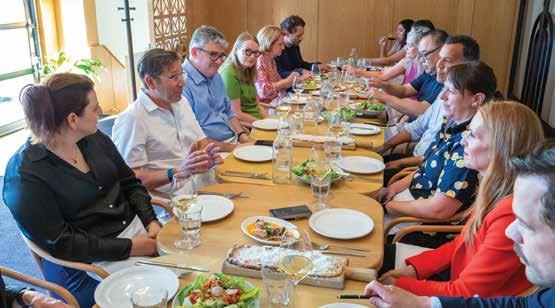
consumers. And that’s going to require a little more complexity. But I think that’s something we should prepare to embrace. This is an opportunity for us to allow ourselves to live in a world where that complexity is part of how we operate, as opposed to trying to find ways that are simple or are a single solution.
We’re all seeing local outlets suffer, shrink and cease to exist from lack of advertising support. Why does it seem like there is still so much resistance when it comes to preventing the fall of local media?
Thompson: The business economics makes it hard; you’re giving away thoughtfulness for
media agency and everything that it does. But that trifecta pivoted, which has been the reason local media and local journalism has struggled in our country for the last decade.
Hunt: Thankfully, there are sizable brands that care about reaching those communities, but the harsh reality is that some ownership groups sit outside the country. I’ve been in meetings where the conversation stops west of Montreal; it doesn’t even go on a grid and you don’t get to advocate for local media because it doesn’t matter. If there was a way to be able to still do right by Canadians in a way that acknowledges the truths of the cost of reach, that’s where the magic is.
Thompson: I think that we will start to get to a stage, hopefully in the next five years, where you have more global CMOs challenging and questioning the media supply chain and the ethical side. You’re starting to see that happen right now with a lot of really senior seasoned leaders talking about this topic. My hope is that eventually Canada is the beneficiary of those conversations.
Is it going to happen in time?
Thompson: I mean, I’m always an optimistic. We have enough entrepreneurial minds that can find ways through this. The only way that it actually stops being scary is if you keep talking about and provoking the conversation. I’m not expecting everybody to suddenly pivot, or be a part of the CMDC and move all of their dollars – just welcome the conversation and the opportunity to at least discuss it and ask the question: where is the audience or opportunity that I’m not seeing?
What about artificial intelligence – what role will it play five years from now?
Agas: I don’t have a perfect answer of what AI is going to do, but it’ll certainly aid in the process. My fear with AI is that while I think it’s helping a lot today with many of our administrative tasks, they are also things that I would have done as a coordinator or as a project manager. They were learning opportunities. So we’re going to have to find ways where the next generation is learning with the use of AI, but also with the presence of mind.
Hunt: Right now it’s doing efficiency and optimization very well and very easily. But in five years, it’ll have that base and it will eventually become predictive. We’re going to be able to show what the system predicted this year and what it predicted last year, which was 100% right. I think it is both scary and reassuring to know that the future may become a little more certain. The data will eventually get there, it’s just not there yet.
Cooke: When it comes to critical thinking or creativity, there’s never been a better time for humans, because machines will only be machines. In the media ecosystem, there will be things that machines will do more efficiently
18 strategyonline.ca
and faster, but you’re going to need brilliant people to figure out what their brand or clients need. I get really excited about all this because I see the opportunities. And then the scary human part of it is that these machines need huge amounts of data, and they’re currently taking data that’s based on disinformation. It’s like a snake eating its own tail. We’re looking at AI in our company, but I think we need smart humans to realize the power of this technology.
Fofana: I think this is the opportunity for us to ensure that the structure around AI does have a cultural anthropologist stuck on it, or somebody who understands the creative part of our industry, and it’s ensuring that as things get rolled out, that it’s integrated into the solutions that we build.
Thompson: To me, it’s the most exciting thing. There are never-ending questions that I want to explore; but the limitation of exploration has always been time. We don’t actually have a lot of time to think about all the plausible options and explore all the potential questions because it’s so incredibly manual. From a strategist perspective, I can appreciate that I can query and build the appropriate investment plan for a client using AI. Instead of sifting through oodles of excel spreadsheets to come up with something that would take me two days. I love the fact that our secondary schools are now teaching how to do proper prompts, because that is a skill unto itself.
Speaking of, what are some of the skills and expertise that media planners and marketers should have to thrive in the future?
Agas: I think we need critical thinking, and that is a hard one to teach. The other thing is the ability to build relationships. During COVID, everybody was stuck in their house and they didn’t have as many interactions with human beings. But relationships are critical in our industry. And we need to help our future leaders understand the importance of that. And then the other thing for me is adaptability. We’re going through so much change and you have to be open and adaptable to understanding how AI, for example, can help your job vs. worrying about it taking your job.

Rocco: I worry a bit sometimes when I’m looking at a piece of creative and I hear “computer says no” when it’s being evaluated. I get best practices. I get that different platform providers are saying, “This is how this works best.” But, as a storyteller, you can take that advice but also add a bit of humanity. I’m not saying that you should ignore everything but I worry that it gets so binary and we lose that humanity. We used to be more generalist and then we went into becoming specialists, and I think we’ve lost that ability for people to think critically, emotionally and with empathy.
Fofana: I think that may be one of the biggest struggles that we have as an industry. If the computer says no, then it’s about having the courage to be able to question, be skeptical, be curious and be creative. And it’s not just the new wave of people, it’s our current teams. We need to allow them the space and the permission to question what’s going on.
Thompson: A lot of that stems from the values of the organization. What do you actually believe the media industry should be achieving and where should it be going?
We’ve talked about opportunities, but what challenges will the industry face five years from?
Fofana: We know that there’s going to be a massive deluge of content in the future, right? Everyone is going to have this onslaught of
content increasingly hitting them on different channels. If we think back to sociology, people can only hold like three or four things in their heads at once. So, people are going to turn off and tune out. And if they don’t want to engage in all of this stuff, what is the industry going to do in order to continue to be relevant?
Jenkyn: I wonder if we’ll go back to how it was in the ’50s when it comes to content? Before there were advertising standards and formats, each program was created by sponsors. And I wonder if this sort of golden age of content is going to be accelerated by AI and if there will be different formats that break the mold. What drives people to a platform is the content, so maybe we will come to an age where it’s full circle and content is sponsored almost entirely by one brand or a couple of brands. They create the content for that and cut out the middleman.
Thompson: The challenge I’m paying most attention to in the next few years is the younger generation’s drive for mindfulness and digital detoxing. We can continue to do what we’re doing, which is excessive consumption, or the consumer will start to gain back control – especially when it comes to subscribing to multiple streamer bills. As for social media, I’d be curious to see if the platforms that we’re talking about today will even exist five years from now…
Cooke: I agree with you. I think we’re going to be at a tipping point really soon and people are going to start to opt out. And then what will we be left with?
19 Summer 2024
CANADA’S 2024 CANNES YOUNG

GABRIEL LAFOND Media Strategist, Cossette Media

NICK CARSON Partnership Marketing Manager, Brizi Inc.

ALPHÉE LAMOTHE Media Strategist, Cossette Media

JENN BAILEY Marketing Specialist, McDonald’s Canada


CHARLES CÔTÉ Copywriter, Rethink CHARLES-ANTOINE THÉRIAULT Freelance Director, Rethink

EMMA LORENZI Copywriter, Courage Inc.

JORDAN BLOOM Junior Art Director, john

SAMMY LO Art Director, Courage Inc.

BENJAMIN NUSCA Art Director, john

ÉLÉONORE TRAHAN Group Supervisor, Touché!

VERONICA VIVERO Assistant Brand Manager, Labatt Breweries of Canada

ALEXANDRE PEPIN Copywriter, LG2

KIMBERLY MONITTO Copywriter, T&Pm

SHALYSE MACKAY Copywriter, Public Inc

ROSEMARIE ST-AMAND Marketing Manager, Omnicom Media Group

LYDIA YOON Associate Product Marketing Manager, Google

NICOLAS ROBERT Executive Producer and Partner, Carton Rouge

LAURA BALDESARRA Designer, T&Pm

AYAAN ABDULLE Project Coordinator, Public Inc

CATALINA NITULEAC Media Manager, Havas Media

AVA GLADMAN Senior Marketing Manager, Molson Coors Beverage Company

SHIWANGI SINGH Search Specialist, Havas Media

ARIELLE UWONKUNDA Brand Manager, Molson Coors Beverage Company

MARK FLANJAK Integrated Producer, Public Inc.

SOPHIA STORTI Copywriter, ZGM Modern Marketing Partners

BRIGITTE PINSONNEAULT Copywriter, Rethink
DYLAN PUN Freelance Director, Public Inc.

LANGMAID Art Director, ZGM Modern Marketing Partners

The Globe and Mail Presents
MEDIA FILM
MARKETERS
DIGITAL
PRINT
st.
st.
GOLD SILVER
ELIZABETH MAHEUX Art Director, Rethink
BRONZE
BROOKE
YOUNG LIONS
Each year, the Canadian Young Lions Competition brings out the best young talent in the advertising and marketing industry. This year, 744 competitors across five competition categories, tackled a challenging brief under extreme time pressure for their chance to qualify and compete in the Global Young Lions Competitions. The competition is fierce.
CONGRATULATIONS TO THE GOLD WINNING TEAMS!
THANK YOU TO OUR JUDGES AND JURY CHAIRS:


JURY CHAIR, MEDIA
Cathy Collier Chief Executive Officer, OMD Canada
JURY CHAIR, MARKETERS
Susan Irving Chief Marketing Officer, Kruger Producs Inc.

JURY CHAIR, PRINT, FILM, DIGITAL
Mary Maddever EVP, Realscreen & strategy, Editorial Director, Brunico Communications
MEDIA:
Benjamin Ferreira, Vice-Président, Stratégie, OMD
Helen Galanis, Chief Executive Officer, Initiative
Richard Ivey, Chief Client Officer
Sophie Laberre, Chief Client Officer, dentsu X
Brooke Leland, Managing Partner, Jungle Media
Jennifer Lewis, Chief Client Officer, Carat
Shannon Lewis, President, CMDC
Matt McGowan, General Manager, Snap Inc.
Caroline Moul, President, PHD Media
Shelley Smit, Chief Executive Officer, Mediabrands Canada
Nikki Stone, Chief Executive Officer, Wavemaker
Alastair Taylor, Chief Executive Officer, Publicis Media Canada
Sarah Thompson, President, dentsu Canada
Noah Vardon, President, Havas Media Canada
PRINT AND FILM:
Xavier Blais, Partner, Executive Creative Director, Rethink
Joseph Bonnici, Chief Creative Officer, Board Member, Tadiem
Anne-Claude Chénier, Chief Creative Officer, Cossette East
Glen D’Souza, Head of Creative, Forsman & Bodenfors
Krystle Mullin, Chief Creative Officer, john st.
Mia Thomsett, Creative Director, The Lesiure Department
Stephanie Yung, Chief Design Officer, Zulu Alpha Kilo
MARKETERS:
Marie-Lou Blais, Chief Marketing Officer, Decathon
Katherine Bond-Debicki, Chief Marketing Officer, KFC Canada
Laura Douglas, Dove Marketing Lead, Unilever
Deyra Jaye Fontaine, Marketing Strategist, Export Development Canada
Adrian Fuoco, VP, Marketing, Pizza Pizza
Quincy Kelman, VP, Marketing, Walt Disney Studios Canada
Steve Levy, Ipsos Canada
Devorah Lithwick, SVP & Chief Brand Officer, Bell Canada
Leslie Malcolm, VP, Marketing, Molson Coors Canada
Aaron Nemoy, Founder & Chief Executive Officer, Crowdiate
Valérie Sapin, VP, Marketing Center of Expertise, Desjardins
Jessica Spaulding, Chief Marketing Officer, PepsiCo Foods Canada
DIGITAL:
Natalie Bomberry, VP, Operations, Pilot PMR
Linda Carte, Creative Director, Fuse Create
Julie Desrochers, Creative Director, Sid Lee
Luc Du Sault, Partner and Chief Creative Officer, LG2
Karen Howe, Founder, The Township Group
Marty Martinez, Chief Creative Officer, TANK Worldwide
Matthew May, Creative Director, Believeco
Roehl Sanchez, Chief Creative Officer, Partner , BIMM
Jenny Smith, President & Executive Creative Director, Ray Agency

The Globe and Mail is proud to be the official Festival representative in Canada for the Cannes Lions International Festival of Creativity. CANADIAN PROGRAM PARTNERS YOUNG LIONS MEDIA CATEGORY SPONSOR

strategyonline.ca/subscribe Stay connected with daily brand news. Sign up for your daily briefing and get context for all the marcom news, research & trends impacting the Canadian market.
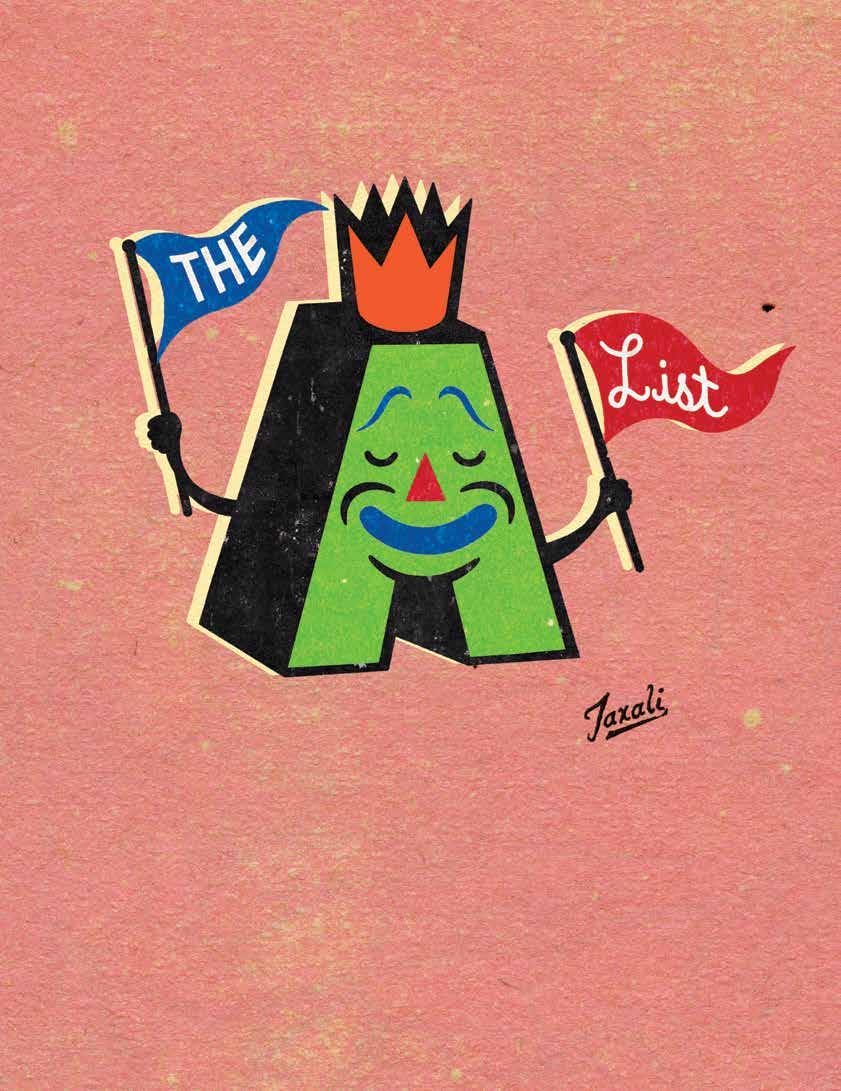
Marketing is on a transformative journey. As brand needs evolve, agency partners have been investing in solutions, skills and new approaches that are propelling Canadian work even higher in global rankings. Here’s how brands have been taking advantage of those capabilities, working with Canada’s award winning shops. Read on to find out more.
SPONSORED SUPPLEMENT | S 23

Mastering the new speed of marketing Zulu Alpha Kilo’s ever-better quest leads to brand wins


IN THE EVER-COMPETITIVE landscape of advertising, where conformity often reigns, Zulu Alpha Kilo (Z.A.K.) strives to be a beacon of contrary thinking, creativity and growth for its clients.
“Sameness is the enemy of creativity,” says agency President and CEO, Mike Sutton. “If you’re a brand that follows the herd, it’s bad for the bottom line. When we get a brief, we ask ourselves ‘how can we solve that in the most unexpected way?”
Above: Z.A.K.’s breakthrough campaign for Booking. com featuring Tina Fey was named Super Bowl LVII’s most effective ad in a research study by Kantar.
ad launched at the Super Bowl has amassed over 134 million views on YouTube, surpassing the 2023 Super Bowl campaign with Melissa McCarthy, which garnered 118 million views.
Speed is one of the biggest challenges facing marketers today and Z.A.K. has introduced a three-speed model to meet the challenge, says McNab. “For example, when a brand needs to quickly capitalize on a cultural moment, our team structure and process are designed to deliver at high speed.”
This is facilitated by continued investment in new technology and talent for its in-house creative content and innovation studio, Zulubot, which is an enabler of speed and efficiency for Z.A.K.’s clients. As an example of what it calls speed three, McNab points to the agency’s recent “4/20”-themed “Pizza Pizza Pre-Rolls” campaign. The promo, which re-imagined pizza as rolled-up joints, was a prime example of a brand taking quick advantage of a culturally relevant moment, going from ideation to national market in just a few weeks.
In March 2024, Z.A.K. was named one of Fast Company’s most innovative companies. The indie shop is no stranger to Fast Company, having been recognized by the magazine’s World-Changing Ideas series for 3 years running (2020, 2021, 2022). “It’s a testament to our entire company and how our offices work together with a common mindset – creativity as the means to drive meaningful business results”, says Stephanie Yung, chief design officer. Innovating thinking from this year includes an AI-inspired take on Andy Warhol’s famous Campbell Soup art. The Z.A.K. team leveraged generative artificial intelligence (AI) to reimagine artwork of the iconic soup can through various artistic styles, which transformed the brand’s Instagram page into a virtual gallery. For Destination BC, the Wall of Wonder leaned into technology and innovation by capturing the beauty of British Columbia while enticing travellers to come and see it for themselves.
Founded by Zak Mroueh in 2008, Z.A.K. has grown to over 180 employees who collaborate across their Toronto, Vancouver and New York offices. It counts brands like Pizza Pizza, Subaru, Bell, Campbells and Booking.com among its clientele and over the past year, its business grew a whopping 42%. It also picked up strategy’s Silver Agency of the year, and landed on AdAge’s 2024 list of Standout Agencies.
Chief operating officer, Christine McNab, believes the shop’s relentless drive for improvement has fueled its success. "It would have been much easier to play it safe, but expanding into new markets and unifying our three offices has made us a stronger agency.”
She points to the recent Booking.com global campaign featuring Tina Fey, her former 30 Rock castmates (and actor Glenn Close) as a high-profile example of multi-office collaboration. Led by chief creative officer Tim Gordon and the New York team, and conceived by a Toronto creative duo, the
But speed isn’t always the answer. CCO’s Jenny Glover and Brian Murray credit the agency’s high caliber strategy team with unearthing powerful consumer insights that have underpinned long-term creative platforms for Z.A.K.’s clients. “We take our time to really nail the platform strategically and creatively. Once that foundation is in place, our team can move at lightning speed to bring innovative creative ideas to life,” says Murray. With another impressive year’s worth of work, it’s no surprise the indie was awarded Platinum status as one of Canada’s Best Managed Companies as vetted by Deloitte. The program recognizes Canadian-owned and managed companies for fearless leadership, relentless innovation, and world-class business practices.
So, if the indie shop’s mantra is to consistently fight sameness, Zulu Alpha Kilo is delivering on that promise. “Nobody gets excited about normal. Normal is invisible,” says Sutton. “We’re a creative business and part of our job is to help marketers move beyond rinse and repeat patterns.”
S 24 | SPONSORED SUPPLEMENT



1 Z.A.K. partnered with Environmental Leadership Canada to create “The Planet’s Scariest Bouquet,” urging action on climate change with Antarctic flowers.
2 ParticipAction's "Fall in with an active crowd" campaign uses satire to promote exercise, correcting misconceptions with a focus on Mall Walking. 3 Pizza Pizza introduced "Pizza Pizza Pre-Rolls" and the "Hot Box," celebrating 4/20 with unique snacks and storage solutions.
4&5 Campbell Company of Canada launched “Campbell’s pAIntings,” reimagining its soup can with AI, blending styles of traditional masters with modern trends. 6 For its latest work under the "Welcome to Uncommon" platform, Subaru Canada introduced the new Crosstrek Wilderness as a ferocious beast secured by chains. 7 In partnership with Destination BC, Z.A.K. immersed international travellers in a Rainforest to Rockies activation – a 26-foot wide wall that appeared in London and Sydney.

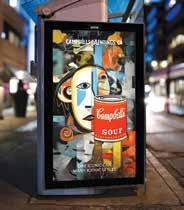



S25
CONTACT:
christine.mcnab@zulualphakilo.com 7 6 3 1 4 5 2
Christine McNab Chief operating officer

Embracing modern creativity to build connected brands
VML Canada delivers transformative growth


MUCH INK HAS BEEN DEDICATED to the merger of Taxi and Wunderman Thompson Canada into VML Canada, with Taxi head Rob Guénette taking the helm as CEO. And it’s not all that surprising. When your client list at launch includes a lineup of international heavyweights like Coca-Cola, Rogers Communications, Colgate-Palmolive, HSBC, Ikea and Microsoft, people pay attention.
But it wasn’t just about the roster. Although Guénette had spent nearly two decades leading Taxi, a creative agency known for its storytelling and branding chops, he recognized that the future of advertising was rapidly evolving, and Taxi needed to evolve, too.
“It wasn’t that Taxi was out of gas,” he explains. “It was that VML had jet fuel.”
Guénette saw the potential to enhance Taxi’s capabilities by leveraging VML’s global reach and technological prowess. VML’s capabilities include an impressive suite of tools and expertise in CRM and commerce as well as deep customer and brand experience. Integrating these with Taxi’s creative cred could propel both entities to new heights and he saw a future in which the two cultures seamlessly merged, creating a company with a robust and competitive creative platform.
This vision extends well beyond Canada’s borders. He wants the new entity to be a net contributor to VML’s global success, participating in high-profile projects “because of our work, our reputation and because there are no gaps in our capabilities.”
Above: VML created a one-night-only comedy special starring popular Quebec comedian Pier-Luc Funk to promote the electric Volkswagen ID.4 titled “Sans Émission,” which generated two million earned media impressions. Right: 1 The “Magic Duos” outdoor campaign for Coca-Cola was an idea that began in Canada and spread worldwide, tying the legendary brand to shared meals and local foods. 2 VML collaborated with Stop The Party to create MissType, an email editor that aimed to revolutionize professional communications by embracing diverse linguistic styles and bridging gender gaps. It was envisioned as a tool to empower individuals to communicate effectively while staying true to their unique voices. 3 The “Ontario Racing Unfiltered” campaign for Ontario Racing and OLG led to more in-track betting and attendance, as well as a video library that amassed more than 16 million views across all platforms.
 CONTACT: Rob Guenette CEO VML Canada
CONTACT: Rob Guenette CEO VML Canada

rob.guenette@vml.com 1 S 26 | SPONSORED SUPPLEMENT
And, he adds, the status quo isn’t good enough. “We have to see our creative output increase,” he says. “We have more places to apply creativity across more places in the customer journey. We are upping our game.”
Only a few months into this brave new world, you can already see that acumen at work.
“It’s about creating connected brands that drive growth,” explains CCO Graham Lang. “We need big ideas that deliver multiple touch points, multiple ways in which consumers can engage with the brand. Whether it’s TV or mobile, influencers or a piece of tech, for us it’s about making sure that we’re creating ecosystems.”
You see it manifest in efforts like the “Ontario Racing Unfiltered” campaign for Ontario Racing and OLG. Lang describes it as a business transformation initiative – revitalizing interest in a sport that had fallen out of mainstream favour. The centrepiece was a five-part docu-series that offered a behind-the-scenes look in a narrative format. It premiered on streaming platforms and spanned social media, OOH and TV and trended as a top sports documentary on Crave, with videos amassing more than 16 million views across platforms.
A campaign for Volkswagen in Quebec, meanwhile, capitalized on off-air hours on local TV stations, which typically greet viewers with a “Sans Émission” message. In its place, VML created a onenight-only comedy special to promote the electric Volkswagen ID.4 titled “Sans Émission,” starring popular Quebec comedian Pier-Luc

Funk. The special was promoted with teaser commercials, OOH ads, paid social media and TV guide listings, and saw more than 63,000 people tune in. The effort generated two million earned media impressions and 94% percent of viewers said they would consider purchase.
Why did it resonate? “We created an experiential touch point where creativity, media and entertainment intersected,” explains Lang. But he’s also quick to point to the collaborative nature of the project and give credit to Funk. “What I have generally found in my career is that, if you have a good idea and you invite people in that can help make it better, great things happen,” he says.
That can certainly be said of the “Magic Duos” campaign for Coca-Cola by WPP Open X and led by VML Canada. An outdoor campaign tying the brand to favourite local dishes (34% of all Coke worldwide is consumed with a meal), the idea was to employ a fraction of the company’s famous logo and typography to tell the story – which required huge amounts of buy-in on the part of the client. The campaign began in Canada but included a global toolkit that saw it picked up in Mexico City and beyond.
“It’s an idea that was born in Canada but has gone global,” says Lang. “If you have brands that really mean something to people, you’ve got to reward them with something interesting. You can’t just be wallpaper. You’ve got to move them, engage them emotionally and create those connections.”

3 2 3 S27

New pathways to growth Zerotrillion helps brands succeed with new formula


THE CLIENTS KNOCKING
on Zerotrillions’ door say a lot about the agency’s work.
“Our clients tend to be in a moment of change, whether that’s a new market entry or product launch, or a strategy they’ve established that isn’t quite working,” says Aubrey Podolsky, global CSO and managing director of the agency’s Toronto office.
Above: To encourage day trips to Niagara Falls, the agency created the "Plan to be Spontaneous" campaign, focusing on the fact that the Falls make a great destination for friends and couples looking to bring new adventure into their lives.
“Their problems require more than delivering against comms briefs that are part of a recycled marketing calendar. So we build them a unique program from the ground up, from consulting, through product and brand strategy, creative, PR and media. There’s too much friction for these functions to operate optimally while being managed by five partners. We’ve built a creative services stack including these competencies and custom processes and platforms necessary to deliver. It really is the ideal way.”
Founded in 2019 by Alex Paquin and actors/producers
Robbie Amell and Italia Ricci, Zerotrillion’s goal is to help clients be the most ambitious versions of themselves, and counts brands including Amazon Prime Video, Destination Canada, car-sharing app Turo, Choice Properties, CNIB Foundation and Niagara Falls Tourism among its clientele.
Paquin credits the Toronto team’s strategic planning for consistently delivering results, implemented and amplified by the 40-plus staffers across a global footprint including New York and Amsterdam, with each office contributing a unique strength. New York offers an outsized capacity in their design studio, and Amsterdam in 3D animation, motion design and
VFX. Podolsky points to the agency’s ongoing work with Niagara Falls as an example of a ground-up refresh.
Zerotrillion won the account against 35 other agencies as the tourism board looked to chart a path out of the pandemic. Recognizing the threat to visitation to the natural wonder, particularly among Americans, the agency looked at consumers’ evolving motivations for travel to guide its strategic approach, and ultimately delivered across the creative services stack, deploying strategy, advertising, content production, PR, and paid media to help drive growth. As a result, Niagara Falls was the fastest growing Canadian tourist destination last year.
“A lot of tourism work has been unsuccessful because they lead with the place, not the mindset of potential travelers. They say something to the effect of ‘discover,’ if they want new people, or ‘rediscover,’ if they want the same people back, and then they put up a nice scenic picture,” Podolsky says. “Post-COVID, the mindset had shifted to wanting reconnection – finding a place that you could reconnect with somebody that was close or affordable.”
Since winning the account, the shop has executed a number of acclaimed campaigns, most recently inviting tourists to “Plan to be Spontaneous.” Targeting couples and friend groups, the campaign builds on the theme of reconnection, encouraging travelers to take an impromptu trip to the Falls as a respite. The campaign has delivered beyond expected hotel booking KPIs.
A unique perspective, and a key driver of Zerotrillion’s success, is its entrepreneurial spirit. The shop’s investment arm, Zerotrillion Ventures, has launched Amsterdam-based sustainable clothing brand Veld and financed Toronto-based restaurant SweetChops, indie photo exhibit and documentary “Dutch Candy” exploring black-market branding of ecstasy and invested in Canadian inclusive brand Alder Apparel.
Meanwhile, the agency’s entertainment division is readying its first project and while details are still under wraps, Podolsky says it will include tie-ins to some of Zerotrillion’s clients. The overarching goal is to showcase the agency’s power and potential in bridging the advertisingentertainment divide. “If we’re going to put all this talent, passion and creativity into making things, it feels like a shame to only create ads that interrupt people,” adds Paquin. “If we can make things that people use to express themselves or be entertained, we want to be putting our resources, passion and talent into that as well. And while Paquin feels they wield an unfair advantage in winning over clients that see the value in working with an agency that understands what it means to be responsible for the bottom line.
“The biggest selling point for us is – we make things people want to consume, and we can do it for you too.”
S 28 | SPONSORED SUPPLEMENT


1 To create excitement for the 4th season launch of its popular comedy Upload, Prime Video worked with Zerotrillion on an influencer and earned media campaign. 2 For Canada’s presence at the WSJ Future of Everything conference, Zerotrillion created immersive video content and designed Canada’s installation. 3 Zerotrillion’s end-to-end approach is exemplified by their work for luxury brand Grown Brilliance, from brand strategy, design, and advertising to retail design, including their Beverly Hills location.
4 Zerotrillion created a brand launch campaign for the new women’s wearable health device Evie, which promises to track everything from sleep patterns to heart rates to menstrual cycles. The hero spot features a highly choreographed dance set against an innovative LED virtual production stage.


 CONTACT: Aubrey Podolsky Managing director & CSO aubrey@zerotrillion.com
CONTACT: Aubrey Podolsky Managing director & CSO aubrey@zerotrillion.com
S29
1 3 3 4 2

Distilling ideas to amplify impact
Edelman
melds PR know-how with creative cred to help brands break through


EDELMAN CANADA ISN’T THE LITTLE PR SHOP it was when it first opened its doors in 1996. With 270 employees and five offices nationwide, the Canadian arm of this global communications firm is barely recognizable in comparison to its ‘90s self.
It may have been the pandemic that introduced a new dynamic, explains Edelman’s Canada’s CCO, Anthony Chelvanathan, because it made the agency more collaborative on a global scale. Or, he reflects, it’s the laser-like focus on creativity that’s making the difference. Whatever the reason, Edelman has evolved beyond the confines of a traditional PR firm.
Edelman’s integrated model combines PR, creative, data and intelligence, influencer, public affairs, paid and performance marketing, and more, making it possible to tackle projects from all angles.
“It comes down to the fundamental belief that it all starts with great work,” explains Chelvanathan. “The last year has been amazing, we’ve been winning a lot of pitches and attracting talented people.”
He notes that the shift to a more comprehensive, creative-focused approach began under global CCO Judy
John’s leadership and her emphasis on creativity as a core agency value.
Part of the agency’s success comes from its ability to focus on basics, Chelvanathan says. The Edelman team is skilled at distilling complicated ideas into their purest form, creating briefs that ignite passion providing clear solutions, which are then applied to whatever platform will have the most impact.
He demonstrates that by explaining the concept of an “emoji brief” – literally being able to distill an idea into a symbol – which is partly how the agency brainstormed the “Allegra Airways” concept with the consumer healthcare client.
The execution saw the team, as part of its health and wellness specialist agency Salutem, create the world’s first digital navigation tool to help allergy sufferers find walking or cycling routes with better air quality, covering all nine million square kilometres of the US down to an accuracy of five meters. But the idea began with a brief that was three emojis long - a person, jail bars and a home. From those three little pictures came a campaign that drove $3 million in sales since March and an increase in Allegra’s share of voice by +14 pts, moving from third to second in category, among other KPIs. The true global nature of how the agency

S 30 | SPONSORED SUPPLEMENT
1
works allowed for a Canadian creative team who were the right fit for the brief to develop the concept.
And that’s not the only time Edelman pushed boundaries. For example, Edelman research found 44% of Canadians have leftover food they throw out after family gatherings, and that 94% feel bad about it, with many wondering how to use leftovers.
So, the agency’s “Between Two Slices” campaign for Hellmann’s offered suggestions, featuring strategically placed OOH, earned and print-ad media across Canada, the US and UK, plus brand-owned creator videos, influencer content and a vanity URL, all stacked together to ensure the campaign reached a broad audience. It netted more than 300 million impressions, 22 million video views and 100% positive sentiment. The campaign was entirely overseen by Edelman, which handled creative, earned, influencer partnerships and digital.
For Ikea Canada’s “SHT” campaign, the agency tackled the idea that double taxation on second-hand items is unfair. It included an open letter in Canada’s biggest newspapers, in-store, Instagram and TikTok, digital, print, online, broadcast and a Change.org petition. The campaign achieved over 50 million impressions, 32,000 signatures and 100% positive/neutral sentiment, sparking discussion and significant earned media coverage.
Advil Canada’s “Head Settings” campaign, meanwhile, addressed the headaches that gamers sometimes experience due to in-game lighting and motion. Partnering with neuroscientist Dr. Séamas Weech, Edelman created a two-and-ahalf minute docu-style online video that explained the phenomenon and offered proactive solutions. It achieved more than five million social impressions across TikTok, Instagram and Twitch, as well as 14,000 clicks and 100% positive sentiment.
“When you see the full breadth of Edelman activated, it’s powerful,” sums Bianca Freedman, CEO of Edelman Canada. “Our strength in what’s considered traditional PR – such as public affairs, earned media and influencer – and focus on building trust, are the secret to incredible work that drives impact for our clients.”

Left: To combat holiday food leftover waste, Edelman worked with Hellmann's to create the "Between Two Slices" campaign offering suggestions on how to reimagine leftovers with Hellmann's. They leveraged strategically placed OOH and print creative across UK, US and Canada. Below 1 Edelman Canada tackled gamers' headaches caused by in-game lighting and sparked widespread conversation through the Advil "Head Settings" campaign. 2 The agency helped Ikea spread the word and spark discussion about the unfair secondhand tax (SHT), they placed open letters in Canada's largest newspapers along with social, in-store, TV and change.org campaign earning them significant coverage. 3 For consumer health brand Allegra, the agency created a simple digital navigation tool to help allergy sufferers find relief during allergy season by providing routes with better air quality across the US. Resulting in an SOV increase of 14 pts for the brand.

CONTACT: Ava Shafman
Senior vice president, head of operations, Canada ava.shafman@edelman.com

S31
2 3

Fusing art and science
Dentsu's strategic approach to marrying creative and data-based tech is generating exciting outcomes.


THE PHRASE "BE TOUGH on the work and be kind to each other," according to Dentsu Canada’s CEO Stephen Kiely, encapsulates the strategic approach that has propelled the agency to a record-breaking year. For Kiely, who has been with Dentsu for 18 years and assumed the role of CEO of the firm’s Canadian media, data, and creative business in 2022, this year’s success can also be attributed to the effort dedicated to uniting creative talent, data-driven tools, and strategic strategic media planning and investment. The agency’s mantra, "innovating to impact," permeates every project undertaken by its 1,220 staff members across offices in Montreal, Toronto, Calgary, and Vancouver.
Above: Dentsu and SkipTheDishes created "The Inflation Cookbook" which tracked the top ten price drops each week across retailers and turned those into shoppable recipes. Taking inflation out of shopping.
Describing it differently, this ethos of being "tough but kind" has resulted in over 40 awards in the past year, including a recent Best in Show Marketing Award and a Best of Discipline One Show Award for its collaboration with Skip the Dishes. Additionally, Dentsu Canada has secured contracts with prominent new clients including: Perrier, Haagen Dazs, Air Miles, and Carlsberg.
Each division of the agency is overseen by seasoned professionals, with renowned creative leader Jordan
Doucette assuming the position of president of Dentsu Creative, in addition to her role as chief creative officer earlier this year. Kiely proudly states that the creative team is producing industry-leading work that is both "beautifully loud and ambitious."
Leading the data side is Walter Flaat, who has been promoted to chief product officer and helps clients use the power of data to inform the development of campaigns.
Dentsu, under Flaat's leadership, is pioneering “unbiased advertising” and AI by collaborating with industry leaders to establish best practices for data use. The team focuses on understanding Canadians better through data collection and fostering an open, secure, and interoperable data landscape, exemplified by the evolution of their data flagship product, Merkury. As a leader in AI enablement, Dentsu integrates AI into its teams and products, with Flaat leading efforts in Canada to support AI enablement in client organizations. His work helps boards navigate shareholder pressures to

1
S 32 | SPONSORED SUPPLEMENT
implement AI effectively and ethically.
The three media brands are led by industry veterans Jennifer Lewis, Carat, Tracey Johnson, iProspect and Moira Gilderson, Dentsu X. Nicole Brown rounds out the leadership team heading up the investment arm of Dentsu. “Our work drives impact at the convergence of marketing, technology and consulting” Kiely says “so it’s critical our media brand leads have that omnipresent vision across the full-funnel spectrum and this is a deep bench of media talent, leadership and strategic thinking”.
Dentsu's recent "Following Wildfire" campaign for ethical apparel company TenTree exemplifies the synergy between its data, creative, and media teams. The campaign encourages social media users to tag nature images with #FollowingWildfire, which are then scanned in real-time by a remote sensing AI algorithm for early signs of wildfires. This innovative approach integrates regional weather and vegetation data to assess the potential fire for ignition, spread and intensity. A trained wildfire specialist reviews positive detections to rule out false positives and validate the geo-location of the image. Social media users are then instructed to contact their local fire authority hotline to advise when there is a confirmed fire detection.
According to Doucette, "Following Wildfire" harnesses the combined power of transformative creativity, data, and technology to provide a tool that enables every Canadian to contribute to wildfire management eefforts with iProspect leading media investment.
Kiely sees campaigns like "Following Wildfire" as a testament to Dentsu Canada's overarching goal: to contribute to culture, improve society and shape the future. “This is a group that's committed to good, but also giving our clients a competitive advantage and I’m just in awe of all of them,” Kiely says.

Below: 1&2 Dentsu brought Mastercard's 2024 Grammys campaign to the center stage with an electrifying SZA performance at Grammy House, encouraging engagement in the Priceless Planet Coalition's mission to restore global forests. By harnessing the mobilizing power of music, Mastercard urged action for the environment, partnering with Lyft and SiriusXM to restore 100 million trees, and fostering positive climate impact and community resilience.3 Dentsu took Subway's 'Globally Inspired' menu ads out of the restaurant and into the world, showcasing the diverse culinary experiences that inspired the new offerings, aimed at appealing to younger Canadians.

 CONTACT: Kate Dobrucki SVP communications kate.dobrucki@dentsu.com
CONTACT: Kate Dobrucki SVP communications kate.dobrucki@dentsu.com
S33
2 3

Think hard. Be brave. Stand out Will makes the greatest impact by avoiding the beaten path


THERE’S MAGIC AND SUBSTANCE in the uncomfortable
Over the years, Vancouver-based Will has resisted the industry trend of trying to handle every aspect of a client’s business. Where many agencies use that strategy to achieve growth, Will stays hyper-focused on being a bold creative agency with a strong strategic focus.
Above: Will created the Teck Copper doorway stunt, leaning into the science and psychology of people to inspire an experience instead of an ad to emotionally connect with audiences.
Since launching in 2014, the founders have focused on growing a diversely talented team who “understand and respect the value of strategy and creativity in equal measure,” says CEO, Ute Preusse.
That approach helped spawn a collaborative agency culture, where everyone at the 36-person team can lean in to inspire bravery, in the teammates, their clients and the brands they represent. Over the past 10 years a culture of trust and transparency has been built between the agency and client partners - a culture where everyone is unafraid to reach into the gut, mine supporting data, and listen hard. All in an effort to fuel courage and confidence to stride towards the unknown and the unconventional.
Will’s “Copper & Health” campaign for Teck Resources, one of Canada’s largest mining companies, is one example where that courage paid off. “In the mining industry, communications are typically directed at the investment community and government bodies. Companies rarely market directly to the public” notes Preusse.
Yet by proving that consumer demand for copper is strong, they influenced investor and government sentiment. Will created interactive stunts that demonstrated the power of copper in high traffic public spaces. They armed people with the knowledge that copper kills viruses and gave them a choice - to walk through a regular door, or one made with virus-killing copper surfaces. Unsurprisingly, people chose the
copper door and became instant advocates.
Copper was added to high-touch public areas, such as door handles and bus handrails, with messaging educating the public about the qualities of the material. The activations were filmed to create paid content that spread the message even further.
“You’re getting a company in a very conservative industry to run with a creative idea,” says CCO, Nick Richards. “That was strategically and creatively very brave [of them].”
Will’s strategic and creative strengths are frequently revealed in their work developing new brand strategies, identities and subsequent campaigns from the ground up. Recent work for the Canada Games – the organization behind the largest amateur multi-sport event in the country – as well as for Think Tank Training Centre, a B.C.-based animation and visual effects school demonstrates their ability to tell brand stories from strategy to identity, website to campaign and beyond. Think Tank is a globally recognized institution for CG education that was, until recently, offered exclusively inperson. But during the pandemic, the school expanded its focus to online learning to gain a broader global audience and elevate the acclaimed CG animation studio to its rightful world-class status.
“The students and teachers at Think Tank are at the sharp end of an already leading industry,” says Richards. “We wanted to convey this concept of never settling, always pushing, finding worlds beyond the imagination to create new realities, and the identity needed to reflect that.”
So Will created a custom typeface (called “Reality Shift”) that constantly evolves, drawing on different letterforms. It used the font for a “completely immersive” website designed to inform, inspire and attract prospective students.
“We feel very confident in our abilities to help clients unearth their core story, something that’s differentiating, true and authentic to them,” says Richards. “And then we amplify that story through brave expressions that move people. That make them feel something.”
The right “solution” to a client’s challenge might be a campaign or it might be a product, experience or something else entirely. As long as it has the desired impact, Preusse says, the idea can be anything – even a case of beer that doubles as a fully functioning acoustic boombox, like the one Will designed and produced to promote a concert series for Vancouver craft brewery Red Truck Beer Company.
Despite recent successes, Will is set on retaining their focus. “Our interest is in continuously becoming better, not bigger,” says Preusse. “We’re not here to chase margins. We’re here to do brave work with brave people. Otherwise, why are we doing this?”
S 34 | SPONSORED SUPPLEMENT

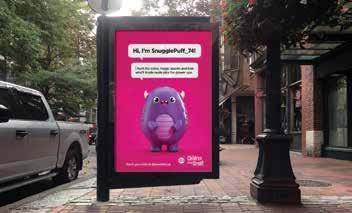


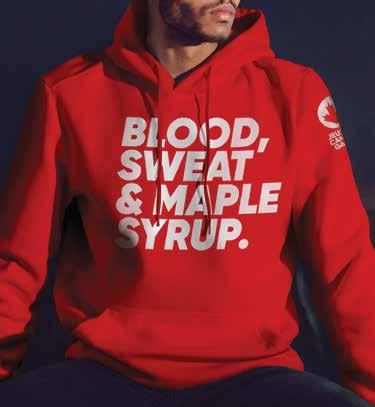
Above: 1 B.C.-based Think Tank promises to shift the prospects and perspectives of its international VFX students, so Will created a fully immersive web experience and a living bespoke typeface to deliver the story. 2 For craft brewery Red Truck Beer Company, the agency turned a case of beer into a functioning passive amplifier to promote a music concert series. 3 To help parents understand the risks of their children’s games and their chat functions, Will contrasted cute online gaming characters with the ugly intentions of the predators lurking behind them. 4 COBS’ “Celebrate Fresh,” a brand platform built around simple illustrations and a charming tone of voice, baked the notion of freshness into the bakery chain’s identity, packaging, product lines and loyalty program. 5 Will’s ‘Spark Greatness’ strategic platform for the Canada Games inspired a new visual identity, brand experiences, campaigns and right down to hoodies!
 CONTACT: Ute Preusse Co-Founder & CEO ute@hiwill.ca
CONTACT: Ute Preusse Co-Founder & CEO ute@hiwill.ca
S35
1 3 4 2 5


Building better connections between brands and audiences Media Experts
doubles down on its domestic specialization

MEDIA EXPERTS HAS A LONG HISTORY of championing the Canadian market. The Montreal-born agency of more than 200 employees has offices in Canada’s three largest cities and a nuanced view of consumers across the country.
Acquired by IPG Mediabrands in 2015, Media Experts has maintained its independent spirit, agility and culture of client care, while leveraging the resources and scale of the global network now available to them. But almost 10 years later, and with a new CEO, it was time for a new beginning.
After spending a year with another agency in the IPG Mediabrands network, Karel Wegert returned to Media Experts last year and resumed his nearly 20-year journey with the agency. His return marked an “opportune time to take a closer look at our positioning, branding and approaches to ensure we are delivering on our client promises while amplifying our dynamic agency culture,” he says. “This had to include not just the historically unique aspects of the agency but also the new and powerful capabilities that being part of IPG Mediabrands has brought.”
At a time when the marketing industry is globalizing, Media Experts combines a unique approach, offering an international breadth of tech, resources and buying power alongside domestic and regional expertise. It’s this combination that has already earned it major new account wins in the past year, including Honda and WestJet, a client of 15 years that is returning after two years with another agency. The first campaigns launched within Media Experts’ first 50 days on the account.
Simply put, the agency aims to champion Canadian brands and brands that want to win in Canada. This comes
Left: Earlier this year, Media Experts welcomed WestJet back as a client after a two-year hiatus.
to life through three key pillars. First, a deep market knowledge through proprietary Canadian research and feet on the ground presence across the country. Second, an agency culture with an entrepreneurial spirit built on over 40 years of client success. Finally, a uniquely Canadian data stack that provides unparalleled audience segmentation capabilities that reaches 29 million unique Canadians across over 5,000 data points.
This sets the foundation that enables everyone at Media Experts to consistently deliver the most effective work for their clients.
For example, when Pizza Pizza wanted to drive online sales and address consumer concerns about rising food prices, Media Experts crafted an attention-grabbing media strategy to complement conversations about “shrinkflation.”
The QSR chain’s “Growflation” campaign offered a large pizza for the price of a small. Media Experts worked with Pizza Pizza to engage with audiences on Reddit, Snapchat, Facebook and Instagram, infusing humour into online discussions about inflation, and showing that the brand cared about Canadians’ financial concerns. The effort helped generate 20,000 online orders and more than $1.5 million in sales.
Understanding Canada’s diverse audiences is a key component of Media Experts’ mission, a strength it demonstrated in a recent push for Truly Hard Seltzer.
The ready-to-drink (RTD) brand has been leaning into support for the arts to differentiate itself in a competitive market. Through its “Make Space” project, it has looked to fund and create opportunities for underrepresented Canadian creatives, particularly those from BIPOC communities.
As part of “Make Space,” the brand hosted the “Truly Flavour Face Off” in Toronto, a live paint battle featuring two teams of artists working together to create art. Media Experts worked to amplify the brand’s message beyond the city by showcasing 50 emerging Canadian artists and utilizing targeted advertising on platforms like YouTube, Reddit and Snapchat.
The campaign resulted in a sold-out event, a boost in ad recall and purchase intent to well above brand benchmarks, and a staggering 16 million impressions on Reddit, thanks to a category takeover on the platform.
“Successes like these are a result of the agency’s long presence in the Canadian market and its deep understanding of what Canadians want,” Wegert says. “Our structure, approaches and technology are uniquely tailored for this market. At a time when so much is being standardized and globalized, our deep understanding of the nuances of Canada offers our clients a distinct advantage. Ultimately, we are more than Media Experts; we are also Canadian Experts.”
S 36 | SPONSORED SUPPLEMENT




1 Media Experts helped Bell showcase its speed advantage within the Quebec market by aligning with F1 in Montreal. They created visual reminders of Bell's speedy internet service with a city-wide takeover with strategically placed OOH 2 Media Experts has been tapped by Honda and Acura to lead their national accounts. They account wins are reflective of the coast-to-coast coverage and innovative tools in play. 3 To help Pizza Pizza cleverly tackle inflation concerns Media Experts worked in collaboration with Zulu Alpha Kilo on their 'Growflation' campaign. The brand infused humor and relevance across strategic digital platforms and distinguished the QSR as a responsive ally amidst the competition 4 Media Experts helped the hard seltzer brand Truly establish itself as a champion of inclusivity with their Make Space Project. They did this through a live art battle, and also provide a platform for over 50 emerging artists to sell their work.
 CONTACT: Karel Wegert CEO karel.wegert@mediaexperts.com
CONTACT: Karel Wegert CEO karel.wegert@mediaexperts.com
S37
1 2 3 4

Creative consultancy approach yields true connections
Leo Burnett’s HumanKind Study finds what moves consumers


THE NAME LEO BURNETT is synonymous with advertising, but like the industry itself, Leo Burnett Canada is evolving, away from a traditional ad agency model and embracing a new approach.
“There were seismic shifts happening in the landscape,” says Ben Tarr, president of Leo Burnett Canada, recalling the moment the agency realized it needed to shift its strategy.
“Many brands were in-housing; PR firms were expanding their service offerings to become more ad-agency-like; and ad agencies themselves were trying to redefine where they fit in the mix. We needed to look at what our true value was to the client, and…it’s always been [our focus on the idea that] that creativity can transform human behaviour,” Tarr says.
The self-reflection led to a totally new approach to the business – that of a “creative consultancy,” Tarr says.
“Clients look to consultants for their strong points of view to help direct them and their business. What consultants don’t often do is execute, and that’s the difference for us. We do both, offering strategic and creative direction across a range of creative types, and then we bring it to life.”
It’s a journey that requires putting people and
Above: The 3rd Edition of The HumanKind Study goes beyond conventional insights to distill the complexities and tensions keeping Canadians up at night, tackling housing, healthcare, inflation, climate, technology and more. Right: 1 Leo Burnett's Pizza Refill for Pizza Hut was a one-day event where customers could bring in an empty box from any competitor and Pizza Hut would replace it for free with their new Handcrafted Crust recipe. The campaign drove people into their nearest Pizza Hut, while also turning a visit to competitors into a revisit to Pizza Hut to try the new product. 2 Leo Burnett and Vector asked would-be players to get out on the field (or rink, court or track) by cancelling a streaming service to reignite their passion for sports and leading a more active life. 3 Created by Leo Burnett for Melanin Gamers, the new toxicity rating system is a helpful tool which provides guidance for parents and starts conversations about the toxicity faced in online gaming. 4 When a truck is a workhorse, getting dirty is part of the job, but when a truck is an off-road superpower, getting dirty is a beautiful thing. It inspired Mudern Art: Modern art made from the mud of the all-new GMC Canyon AT4X. 5 “The Rental” campaign for Bell leaned into the insight that horror sells. Leo Burnett created a satirical play on the power of Bell’s broadband fibre network, and the fear of going without it.


S 38 | SPONSORED SUPPLEMENT
1 2
behaviour at the centre of how the agency thinks, an approach that they’ve called HumanKind. The approach focuses on a deep(er), more insightful understanding of the target audience and its relationship with the brand and product category.
Leo Burnett himself famously said, “what helps people, helps business,” and it’s heralded as one of the agency’s founding principles. It was also a significant motivation for the move from traditional ad agency to creative consultancy.
To fuel the new model, and bring those founding principles to life, the agency launched the HumanKind Study, an annual survey of over 4,000 people that investigates the challenges and problems Canadians face. It’s an exercise that not only provides insight into how brands can address some of those challenges and problems, but it also fills a gap in the marketplace.
But it had to be more than just a philosophy and an approach, adds Tahir Ahmad, Leo Burnett Canada’s chief strategy officer. “It was important to make it tangible. Being human-centric isn’t unique, but going deeper than the headlines or a single statistic and really showing the client that we understand their audience, how human beings live, what’s impacting the quality of their lives and, more importantly, what the brand can do to impact that. That’s different.”
Ultimately, as the agency increasingly leaned into its role as creative consultant, it led to a better understanding of audiences in general. “It’s so easy to scroll past ‘advertising’ right now,” says Steve Persico, co-chief creative officer. It’s not about one ad being better than another anymore. “The better we understand
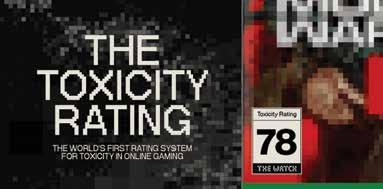

people, the more we realize that we are in competition with music, movies… everything that’s on your phone. So the more we can be upstream with clients and help them create true connections with people, the better off we’ll be.”
As an example, the team points to its Kellogg’s Unsubscribe campaign in early 2023. It was built around the idea that people were finding it hard to get back to normal life after COVID shutdowns. The HumanKind research and insights led them to focus on people and purpose. Use of streaming services skyrocketed during COVID, so the idea Leo Burnett brought to the table was to get Canadians to unsubscribe to their streamers and get out of the house and be active. The idea resonated with Canadians, resulting in a 17% increase in Vector cereal sales, over 165 media stories, and over 63 million media impressions.
That said, there’s still a journey to get to that deep insight, “to find the jumping-off point from HumanKind, and how it works with client data points and the state of their business,” adds Leo Burnett Canada’s managing director, Natasha Dagenais. “And it can’t happen without strong collaboration.” The client needs to be on the same journey, applying their expertise and knowledge to the ideas Leo garners through its research and talent.
The re-focusing of the agency’s strategy is paying off. In 2023, Leo Burnett Canada is having its strongest year yet, with doubledigit growth and seven new clients, including Starbucks, Pizza Hut, Canadian Pension Plan, Loblaw company and TD in the US.

 CONTACT: Richard Newman VP development and communications richard.newman@leoburnett.ca
CONTACT: Richard Newman VP development and communications richard.newman@leoburnett.ca
S39
3 5 4

Charting a path for brands’ future needs
Weber Shandwick maps out impactful solutions


THE PHRASE “CLIENTS FIRST” is something many agencies tout, but for Toronto-based Weber Shandwick, it’s the fuel for the agency’s transformation from PR shop to a strategic communications agency.
“We’re all about our relationships,” says president and CEO Greg Power. “The focus is on organic growth with current clients. That’s our first priority – build success for the clients we serve and be selective about new business.”
The focus entails new data and insights products and a dedication to staying ahead of what marketers want, before they want it. The strategy has three pillars, Power explains.
The first: “Collaboration: Working really well together as colleagues.” The second? “Clients first: Be in the work, and make a difference.” And the third is less an idea and more a requisite of today’s marketing landscape: “Innovate: Keep changing and evolving.”
Power says the agency’s approach is built on the concept of “value-based communities,” with teams built around four areas of “craft”, “client experience, insights, content and integrated media.”
This future-proofs the organization by ensuring it stays relevant and adds value by offering ever-evolving services and expertise. It also creates sustainable career paths, helping the agency to recruit and keep talent.
To fuel organic growth for its integrated offering, Power says it became important to lean into areas where the agency is super-qualified to add value. To that end, Weber Shandwick created the Un/Predictions Report, an annual study first published in 2023. It provides analysis and insight into “megatrends” in policy, technology, media and culture, with the goal of providing CEOs with signposts to chart their brands’ paths forward.
“Today’s business leaders are contending with a global
Left: The agency worked with McDonald's and Simu Liu on PR to drive donations for the 29th McHappy Day
landscape that is noisier and more complex than ever.
What may appear as a small business decision can inspire, enflame, and polarize, shifting a progressive idea into a political minefield,” he says. Some brands have had missteps and strayed into politics. But what is the right balance?
“ESG is now a tainted term,” says Power. “But the issues it was created to address remain and so does the responsibility to act on them to them expectations in a stakeholder economy.”
Un/Predictions report is designed to give execs insight into the balancing act for their corporate strategies and ESG-related goals. Ultimately, it’s designed as a playbook.
As a result, the agency is in a position to look at trends from a global perspective, he says, and identify ways for brands to tap into those conversations, or anticipate how they can affect decision-making.
Power calls out the sustainability-related work the agency has done for the Coca-Cola Company in Canada. In October 2023, the brand announced a transition to 100% recycled plastic (rPET) for its 500-mL sparkling beverage bottles (excluding caps and labels) Weber Shandwick created the “Replay Arcade,” a popup vintage arcade in downtown Toronto showcasing the multiple lives of rPET plastic bottles through gameplay.
The key was to address the skepticism many Canadians hold when it comes to environmental claims by brands while providing information to consumers in an engaging, fun way that was easy to understand.
But campaigns like the “Replay Arcade” are really only possible when you work closely with the brand, Power says.
This kind of work is based on understanding The CocaCola Company's global sustainability commitments related to the Canadian market, and how we can tell a compelling story about their local impact.
“This is a relationship-driven business, and the closer you stay to your client, the more you understand their business. That puts you in a strong position to see what they need,” he explains.
That focus is key to the agency’s organic growth and longterm roster. “McDonald’s has been a client for 35 years,” Power says. “Royal Bank of Canada has been a client for 13 years. General Motors for 13 years. Air Canada, seven years. Those are the things that matter; trust, commitment and being highly responsive when the need is greatest.”
Which helps the agency to position itself to meet future brand needs. “When you’re additive, when you perform, you get a seat at the table and a voice in where the client is going.”
S 40 | SPONSORED SUPPLEMENT




1 Love & Nudes, an inclusive lingerie brand by and for women of colour, created The Stage Zero Collection –the world’s first breast cancer self-examining tool that helps Black women identify the signs of breast cancer on darker skin tone. 2 Two of the four tones created for The Stage Zero Collection on display at launch in front of Shop20, Scarborough Town Centre, on World Cancer Day, during Black History Month. 3 & 4 The Replay Arcade, presented by The Coca-Cola Company celebrated the company's transition to 100% recycled plastic (rPET) bottles (excluding caps and labels) across their entire 500ml sparkling beverage portfolio in Canada and invited guests to recycle an empty plastic beverage bottle in exchange for arcade tokens and a Coca-Cola beverage in a 100% rPET bottle.

S41
1 4 3 2 CONTACT: Greg
President
CEO, Weber Shandwick
gpower@webershandwick.com
Power
and
Canada

Ruthless creativity forges new paths for PR
Pomp & Circumstance delivers the extra and then some


THERE’S A SIMPLE REASON WHY Pomp & Circumstance is the fastest-growing independent PR agency in Canada, says Amanda Alvaro, its co-founder and president.
“We’re putting out some of the most creative work in the industry,” Alvaro says.
The ethos of creativity has allowed Pomp & Circumstance (P&C) to grow substantially since its founding in 2015. The Toronto-based agency now has 40 employees and last year secured a spot on The Globe and Mail’s ranking of “Canada’s Top Growing Companies.”
Alvaro notes much of P&C’s growth stems from existing clients who seek out the agency for a single service, such as media relations, “and then see within our four walls we’re able to meet so many more of their needs.”
PR shops like P&C that provide multiple services have become “the go-to stop for a lot of brands,” she says. The complex marketing landscape means brands need agencies that can provide a holistic approach to content and storytelling, not only coming up with the creative to support it but the social and digital expertise to successfully get it out into the world. And P&C has been serving that need –and beyond.
P&C’s work for Air Miles’ “Carousel of Dreams” contest is an example of the agency flexing its creative and media chops. It set up the spot as a TikTok takeover, using CGI to make a video of a TTC subway pulling into a station that looks like a baggage carousel filled with suitcases.
TikTokkers found it compelling and the platform told P&C it was the best performing paid ad campaign it had seen in Canada and it ultimately generated over 15.4 million impressions on paid and organic channels.
The agency adapted the original campaign featuring mega-influencer Emma Chamberlain for the Canadian
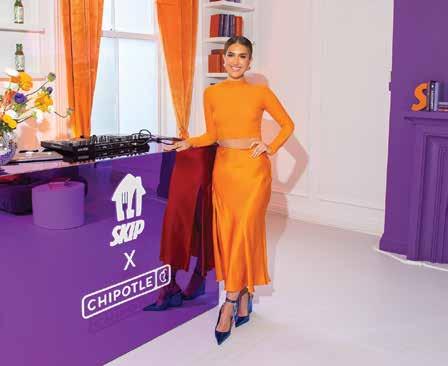
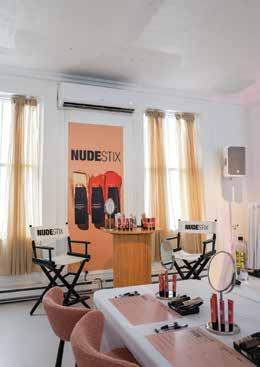
S 42 | SPONSORED SUPPLEMENT
2 1 3
audience to show how Canon digital cameras provide superior photo quality than smartphone cameras. With placements on YouTube, TikTok and Spotify, the campaign generated an “enormous” 30,000 purchase conversions, Alvaro says. “Canon was thrilled, and we were excited about taking something that may be considered older technology, pairing it with someone who is clearly in the zeitgeist of the moment, and making it current and contemporary,” she adds. The Canon campaign was adapted by P&C’s Bonus Track division, which brings together a specialized team of designers, influencer managers, media buyers, art and creative directors, and branding strategy experts to build on its content creation, paid media, and brand strategy work.
Bonus Track has grown tremendously since its inception two years ago, attracting division-specific clients like Canon, Fanduel and JLL, as well as taking on existing P&C clients.
Event production has been a feature of P&C since the start, but the agency has also expanded its experiential arm significantly. “There is a growing desire for brands to connect with people not just in the digital world, but physically,” Alvaro notes.
The move has paid off, with P&C named experiential marketing AOR for BMW Canada this year.
P&C is the national AOR for brands such as Dermalogica, Air Miles, SkipTheDishes, Tiffany & Co and eBay, and U.S. brands like QSR Shake Shack and the Nobu restaurant chain have selected the agency for their Canadian launches.
“When a client comes to us, they are expecting big and bold in the creative,” Alvaro says. “I think that’s why marketers choose us - because they want to push the limits.”
Left: As newly appointed AOR for BMW Canada, P&C will be working with the luxury brand to re-imagine their XM events while fostering new ways to meet their target consumer throughout Canada. Below: 1 Pomp brought TikTok star Tinx to Canada to launch Chipotle on Skip the Dishes. With events that included a signature Tinx Bowl available exclusively on Skip in Ontario and BC for one weekend, the campaign generated 42.9 million program impressions. 2 P&C launched the Nude World Tour to help beauty and skincare brand Nudestix ring in its 10th anniversary. It launched in Los Angeles with a three- day event with programming ranging from VIP dinners to fitness classes led by celebrity instructors that garnered more than 11 million impressions and $1.6M in EMV for the events in Toronto & LA. 3 Convincing Gen Z and Alpha to use traditional cameras instead of their phones is no small feat, but Pomp succeeded in a campaign for Canon that tapped American influencer Emma Chamberlain, using Spotify, YouTube and TikTok. 4 Air Miles tasked Pomp with developing a launch strategy for its new travel booking platform. The agency developed an approach that included media outreach, an influencer program and speaking engagements for key executives in travel and loyalty media.

CONTACT: Erika Ceddia Partner, vice-president of accounts & business development erika@pomppr.com


4
S43

From ads to actions
DDB Canada leverages its legacy to spark attention
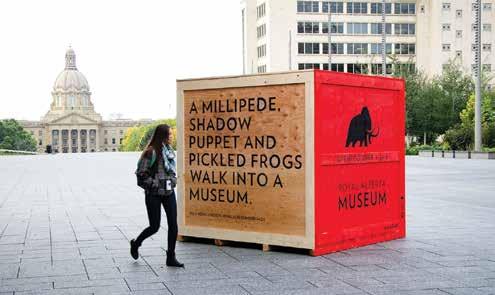

SEVENTY-FIVE YEARS AFTER ICONIC US-based agency DDB was formed, its Canadian counterpart continues to deliver on its promise to do things differently, says DDB Canada managing director Martha Jamieson.
“That idea that Doyle Dayne and Bernbach built long ago is still really at the core of the brand,” she emphasizes. “It’s about creativity and consumer insights and doing things that move people to take an action that benefits our clients’ brands.”
Above: DDB Canada was tasked with breathing new life into the Royal Alberta Museum for its move into new downtown Edmonton digs after a threeyear closure. The campaign included a new logo and pop ups of large packing crates throughout the city to build buzz for the opening and drive visits.
The full-service agency has more than 45 employees and presence in Edmonton, Vancouver, Toronto and Montreal. It’s a “legacy brand” that moves forward with the times, says Eva Polis, a 25-year veteran of the agency and its executive creative director. "The world changes and we change with it. Clients entrust us with their challenge and we deliver a solution they never would have thought of themselves."
Often, this means taking an unexpected tack at a steadfast brand. There’s no better example of tradition than a museum, so when Edmonton’s Royal Alberta Museum closed its doors in order to move into a new location, DDB was challenged to put a fresh spin on a local institution.
The brief was to update the brand, spur annual membership and ticket sales and build buzz for the grand-reopening day.
The museum’s previous woolly mammoth logo was given a sleek, modern update and created a new tagline to go with it: “Feed your curiosity.” The new look was introduced to the city in a cheeky teaser campaign that included pop-ups of mysterious large packing crates throughout the city, building anticipation and
curiosity around the re-opening.
Tickets for the big day were snapped up in under six hours, vastly outpacing the initial forecast of seven days. And average monthly visits in the first three months of operation exceeded targets by 33%.
DDB Canada’s capabilities were once again put to the test with another major rebrand: a new moniker and brand identity for Edmonton’s CFL football team after it discontinued its original name, the Edmonton Eskimos.
Fans were recruited to contribute ideas and almost 15,000 suggestions came in. Then, over 40,000 fans weighed in on a shortlist of seven finalists, choosing Edmonton Elks as the winner. The “Antler Up” launch video for the new name had more than 500,000 views in its first week, while merchandise sales saw triple-digit growth in the first two games.
“The response was overwhelmingly positive,” Jamieson says. “The team embraced it, the community embraced it, the media embraced it. I don’t think we could have asked for a better launch.”
Eve Rémillard Larose, CEO of TBWA\Group Canada which oversees DDB Canada, notes that DDB is “really strong at changing consumer behaviour.” DDB’s work for Alberta Health Services on smoking cessation is a case in point.
The provincial health provider came to DDB seeking a clever, but simple poster campaign to convince kids not to start smoking.
“We could have delivered a poster campaign with a clever headline,” Polis says. “But would it really have made a difference?”
Instead, the agency came at the problem from another angle and created a role-playing board game for schools called Shadows of the Academy. In it, kids band together to protect each other from harm and through play, learn to resist peer pressure to light up.
Shadows of the Academy not only became an official part of Alberta’s school curriculum, which tripled the initial order of 5,000 games, but was picked up by school boards across the country.
“We look at things differently and really think about the challenge in front of us and how we can create something impactful. We do that every single time we get a brief,” Jamieson says.
They applied the same kind of thinking for longtime client STARS Lottery, which raises funds for helicopter air rescue services. Instead of only focusing on prizes, like many of its competitors, DDB created a campaign that focused on the cause, balancing empathy with the joy of winning.
“It can’t just be one or another,” she says. “That’s why we’ve been successful at keeping the business for so many years.”
S 44 | SPONSORED SUPPLEMENT




Left: 1 The best of both worlds. Balancing alcohol consumption and mocktails. This non-traditional solution for Alberta Gaming Liquor and Cannabis DrinkSense was an ad campaign complemented with make-your- own mocktail boxes. 2 DDB was tasked with creating a theme and brand identity for RGD DesignThinkers 2022, Canada’s largest graphic design conference. The theme “Defy” was a reminder that growth and change only happen when people take risks or break rules. 3 DDB's design work for the Edmonton International Airport's annual report received a Cannes Lions shortlist. 4 For Alberta Health Services, DDB created a role-playing card game played at schools in which kids learn to resist the pressure to start smoking. The initial order of 5,000 games was tripled and the game became an official part of the provincial school curriculum. 5 To raise funds for long time client STARS Lottery, DDB expertly balanced the messaging between the cause and prizes at stake, resulting in phenomenal sales. 6 Geminai Rising is an online, interactive, multi-component game developed for junior high school students. This dynamic teaching resource builds on Shadows of the Academy for Alberta Health Services.




S45
1 3 2 6 5 4
martha.jamieson@ddbcanada.com
CONTACT: Martha Jamieson Managing director


Indie Spirit meets full-service bench strength
G&G, a division of Acart, bolsters its offerings

FOR OVER A DECADE, Toronto’s G&G Advertising – AKA Giants & Gentlemen – has supported big brands like Harvey’s, Enercare, RBC, the Canadian Internet Registry Authority (CIRA), and Clover Leaf. Despite having a roster of high-profile clients, G&G co-founder and co-CCO Alanna Nathanson says it’s been a tough year for small shops. So she and her partner Natalie Armata strategized on the right solution for the next phase of the agency.
As it turns out, the answer was strength in complementary indies. In May, G&G was acquired by Acart Communications, an Ottawa-based agency known for its work with the Ottawa Senators and Food Cycler. Under the deal, G&G kept its name and branding and now operates as a specialist brand under the Acart Communications umbrella.
Once constrained by its size and resources, G&G now has access to a robust media trade desk, motion graphics team, developers, a full suite of strategic offerings and leadership. ”It’s a game-changer for our clients to have access to all of these competencies, for highly responsive, cost-effective and successful campaigns,” Armata notes. G&G gets to retain and continue to build the hands-on partnership service that’s become part of its core while adding bench strength and services for clients who like the agility of an independent agency but want to work with a one-stop-shop.
Acart’s CRO Andrew McWiggan and its CSO Theresa Forman, have joined Armata and Nathanson on the G&G executive team and, according to Nathanson, the transition has been “seamless.”
“The chemistry was there from the start; we all share the same ethos and work ethic. We knew right away that we were better together,” says Armata.
Left: To help Canadian business owners consider a .CA over a .COM, G&G leveraged the Canada Goose, who, while being a proud symbol of Canada, are also complete jerks. Our “anti-mascot” nudged small business owners into make the right domain choice and won a silver CMA Award.
"We are excited to contribute a robust strategic practice to G+G clients. Expanding our footprint in Toronto, widening our market segmentation, and adding complementary skills were all a win-win-win, it's been a wonderful experience," says Forman.
It’s a partnership that builds on what makes G&G most effective: A model and USP that sees the agency as part of the client’s team helping to build out a long term brand vision.
“Our ideal client sees us as a partner. They want to collaborate,” McWiggan adds, “so we can drive results to build the business together.”
Nathanson calls out CIRA’s 2022 “Listen to the goose” campaign. Getting audiences to talk about, much less think about, the importance of registering a .CA domain isn’t easy. “It’s a tough, low-interest category,” Nathanson admits.
The solution was to go for laughs, opting for a fun, irreverent approach that only becomes possible when the agency has

S 46 | SPONSORED SUPPLEMENT
1
built trust with the brand. The spots feature a Canada goose as a .CA enforcer, using its famously ornery nature to “guide” undecided domain buyers into clicking the Canadian choice. “Humour became the great unifier,” she notes.
Another important campaign for G&G was its ongoing work for the Assaulted Women’s Helpline (AWHL) in Ontario. This year’s campaign was an evolution of 2023’s “When you live with abuse, there’s no easy way out” work, which was built around the insight that, on average, it takes a woman seven attempts to leave an abusive relationship.
That campaign featured the exterior of a house with no entrances or windows, a creative concept that G&G and AWHL wanted to expand. “This year, we shifted the point of view, staging the scene like an open house, but once people came in, everything would seal up, and there would be no way out.”
The new iteration needed to convey the complexities around being psychologically trapped versus physically, a nuanced POV that Nathanson says required close collaboration and the deep understanding borne out of a long, close client relationship.
The campaign exceeded expectations, garnering over three million impressions and earning national coverage in over 10 different media outlets.
The attention- and award-winning work underscores the strength of the small shop, and with robust end-to-end services, G&G can provide a top tier client experience, data to optimize results, and production efficiencies like never before. Nathanson says, "Our model, and the people we work with, are still all about being able and eager to wear many hats and be part of building the business. Our tone is light-hearted, self-deprecating and fun. Advertising is supposed to be fun. Yes, the work can be hard, and you need to take it seriously… but don’t take yourself too seriously.”

Below: 1 & 2 To highlight the complexities of an abusive relationship G&G worked with Assaulted Women's Helpline to create the "Inescapable House" experience: an actual open house complete with realtor signs and brochures that sealed up once wouldbe house hunters entered leaving no escape much like those living that experience in IRL. Clues were also left in each room, such as make-up in the bathroom to cover up bruises and flowers bought by the abuser to show the cycle.

CONTACT: Andrew McWiggan, Partner & CRO andrew.mcwiggan@gandgadvertising.com

S47
2





TIM HORTONS’ NEXT BIG BALANCING
AS IT CELEBRATES ITS 60TH, THE QSR CONTINUES TO REBUILD TRUST WITH CANADIANS BY MODERNIZING ITS BRAND, WHILE ALSO PROTECTING ITS LEGACY. BY
MEGAN HAYNES
For Tim Hortons, everything is about finding equilibrium. The Canadian chain navigates a delicate balance between catering to die-hard loyalists who crave the familiarity of daily coffee and doughnuts, and newer patrons – particularly adventurous Gen Zers – seeking novel experiences. It has to get the right combination of retail promotions to drive store sales and bigger brand marketing to build longer-term loyalty. And now, as it celebrates its 60th anniversary, Tim Hortons needs to find a balance in preserving its robust legacy while embracing a modern outlook for the future.
For CMO Hope Bagozzi, who joined the QSR in 2020 after 15 years working for McDonald’s, it’s all about getting
the product mix just right. She sees Tims’ food selection as the key to unlocking future growth, and she’s on a quest to move the chain, once known almost exclusively for its coffee and doughnuts, “beyond brewed.”
As she looks at the coming decade, she sees huge opportunities in new meal occasions, like late afternoon and evening snacks, as well as in beverage offerings, such as cold brews and iced lattes. And, as she sees it, the marketing activity over the past decade has been setting the stage for those efforts.
“I think the whole thing for Tim’s is about [conveying] authenticity,” she says. “Everything we do… it’s about trustworthiness. I think Tim’s is a brand that people can rely on, and so I think our marketing needs to have that
48 strategyonline.ca




BALANCING ACT
same approach so that it’s forthright, it’s honest.”
It’s been 10 years since Tim Hortons’ $12-billion merger with Burger King. The deal, backed by Brazilian firm 3G Capital, created a new parent company Restaurant Brands International (RBI) and set the popular Canadian coffee chain on a new path. And though it hasn’t always been smooth sailing, it’s definitely been a ride.
A 50th birthday present
In the 2010s, Tim Hortons was on a brand high. As it approached five decades in business, the chain had more than 4,000 locations and pulled in an annual revenue of more than $2.8 billion. Tims’ 2011 report estimated that it commanded 41% of overall QSR share and 28% of the quick-serve coffee market in Canada.
The Tim Hortons brand had a strong connection with Canadians, in no small part thanks to the popular and effective “True Stories” campaign by then-AOR
J. Walter Thompson (JWT). The campaign ran in various iterations from 1994 to 2008, and included iconic
Clockwise from top left: Miles G. “Tim” Horton opened the first store in Hamilton, ON in 1964; “Snowpeople” in 2020 carried a powerful message about inclusivity; Canadians responded so well to “Timbiebs” that the QSR partnered with Justin Bieber again for “Biebs Brew”; vintage clothing sold at TimShop; the brand continues to reflect a diverse Canada with its “True Stories” platform; the same D&I messaging plays out in its “Let’s Up Our Game” campaign with Paralympian hockey player James Dunn.
commercials such as the refugee father stocking up on winter gear (and coffee) to meet his newly arrived family, as well as the father-son pair watching the grandson at hockey practice, also with coffee in tow. Each heartwarming spot showcased the ubiquity and importance of the brand in Canadians’ lives.
It was the overall strength of the brand and Tims’ growth potential that attracted the Burger King merger in the first place, according to media reports at the time.
The deal closed December 15, 2014, and then Tim Hortons hit some turbulence. In January 2015 – less than a month later – news broke about mass layoffs at the head office, with reports estimating upwards of 25% of the company’s head office employees had been let go. Well into 2018, franchise owners and RBI waged a public battle over fees, and in that same year, the chain received flak for changes to its worker health and dental benefits program following minimum wage hikes.
Trust in the brand took a dive. A 2016 poll by Leger saw the company dip from a high of fourth-most trusted brand in Canada all the way to 27th place. In 2018, a reputation poll from the University of Victoria saw Tims rank as the 203rd-most trusted brand in Canada, when just three years earlier it held the top spot.
And this was impacting profit, with sales growth slowing significantly between 2015, when it peaked at 5.5%, and 2019, when it saw a decline of 0.3%.
Potentially compounding the issue, marketing dollars shifted away from brand-building and towards product promotion – with Bagozzi estimating that upwards of 80% of spend was going towards retail promotion at the time, focused primarily on pushing the new limited-time product launches.
This was problematic, Bagozzi says. “There probably wasn’t much traction because [the menu items] were here for a limited time, and then it would be onto the next thing the next month,” she says. “That is exciting for guests to try, [but] there wasn’t the development of longterm platforms that keep them sticky.”
Turning tides
In 2018, RBI’s then-CEO Daniel Schwartz said in an earnings call that the company “had to take urgent and decisive action” to address the issues of falling brand sales and trust.
New talent joined the Tim Hortons C-Suite, including then-global CMO and now-president Axel Schwan. In
49 Summer 2024
2018, Tims brought on new agency partners including Toronto-based Zulu Alpha Kilo and Miami shop Gut, ending a nearly three-decade partnership with JWT. Finally, the company announced an $800-million revitalization plan, which included improving product quality, as well as investing in the Tims Rewards program and other digital offerings – all aimed at winning back consumer trust.
As part of the company’s “Back To Basics” plan, Schwan’s early work honed in on the brand’s core


Above: Winning over younger Canadians meant creating a Tim Hortons-themed obstacle course on gaming platform Roblox; the QSR’s 60th marketing includes the return of retro doughnuts.
building blocks, focusing on things like coffee and community. Early campaigns under his direction included a look at the chain’s coffee making process, with an ad spotlighting the humble coffee bean as it makes it way to cups, featuring real coffee growers and roasters. Another spot invited neighbours who’d never met to share a coffee and get to know each other.
The creative set the tone for what would be the biggest investment in brand-building since RBI’s acquisition.
“At its best, [Tims can be] a brand that connects with Canadians in an authentic way,” says Dino Demopoulos,
former chief strategy officer at Gut. “[However], what we were seeing was Canadians felt disappointed... that the brand that they love wasn’t showing up… in a way that felt authentic and true to what they expected. People were questioning what was happening [at the company].”
To rebuild that trust and reconnect with Canadians, Gut, which formally took over as AOR in 2021, dusted off the spirit of the “True Stories” campaign. The original work was highly effective at reflecting stories about how Canadians interacted with the brand, Demopoulos says, and it was insight that could apply to all future creative from the company.
“One of the key principles that we established was that we would use real people in the advertising,” he says. “As part of that recommitment to Canadians, we would put Canadians front-and-centre in order to depict the relationship they have with the brand.” This resulted in creative from promotions and brand marketing to Camp Day campaigns featuring real customers, employees and store owners, rather than actors.
Even when creative doesn’t feature “real people,” Demopoulos says it’s important that it reflects Canadian values. He points to the 2020 holiday campaign “Snow People,” which showcased a myriad of snow men and women dressed in culturally unique garb. Creative was inspired by the idea that Canadians – many of whom come from various nations, races, religions and heritage – will often dress their snow creatures in clothing from their ancestral lands.
The re-imagined “True Stories” platform was a roaring success, he says, with brand positivity metrics all trending upwards. UVic’s annual brand trust survey has seen the chain creeping back up its ranking – landing at 156th in 2023.
Future legacies
Bagozzi says the company has shifted to a better equilibrium between promotional campaigns (now approximately 60% vs. 80% of the marketing spend) and bigger brand-building activations.
Demopoulos adds that the brand has had to find the right balance between heartfelt legacy and fun modernity, particularly when bringing younger consumers and new Canadians to the fold. He points to the 2021 “TimBiebs” promo, which saw Canadian singer Justin Bieber curate and promote new Timbits flavours and other merch in stores, as a prime example.
“It felt like a new face for Tims, but still connected to the brand because Bieber got his start busking outside of the restaurants,” he says. “Even the design [of the campaign] felt new and interesting, but it also had a nod to the classic iconic Tims logo, identity and brand.”
Tim Hortons is also experimenting with new tech platforms – such as its loyalty app, now home to the fully
50 strategyonline.ca









Here’s to 60 years of keeping it fresh


















































10 PRODUCT LAUNCHES THAT SHAPED TIM HORTONS
1976: Tim Hortons debuts the now-famous TimBit, which would become the Canadian household name for doughnut holes everywhere.
1986: The annual Roll up the Rim to Win program launches and goes on to drive sales at the QSR for more than 30 years.
1995: Sandwiches, the first non-bakery-style item added to the menu, kickstarts the brand’s foray into new mealtimes.
1999: The blended Ice Cap was an early test of cold coffee drinks. Tims would later add other blended flavours, including fruit smoothies (2011) and lemonade (2012).
2004: Seeing an opportunity to expand options for tea drinkers in Canada, steeped tea – brewed in a similar manner as coffee – joined the menu.
2006: The QSR, eyeing McDonald’s growing dominance in the breakfast category, began serving hot breakfast sandwiches (pictured above).
2014: To address changing coffee palettes, Tim Hortons introduced Dark Roast to its coffee roster. It would relaunch the offering in 2021.
2011: Joining the likes of Starbucks and Second Cup, Tims introduced espresso-based drinks (pictured right).

2021: Cold brew coffee joined the company’s other chilled drink options.
2022: Tims is the latest QSR to jump on the pizza trend with the launch of Cilantro Lime Chicken and Habanero Chicken, flavours that were also added to the wrap menu.
2024: The QSR adds pizza to its menu.
virtual “Roll up the Rim to Win” promotion, or the custombuilt Roblox experience, which saw gamers race through a Tims-themed obstacle course. It’s also expanding the brand footprint (literally) with an Adidas team up on a limitededition National Doughnut Day shoe collection (see pg .9), and is producing a 70-minute musical entitled “The Last Timbit.”
Next for Bagozzi is a chance to connect with consumers through new meal-time occasions. Since she’s joined, Tims has invested further on other coffee beverages, like cold brews and espresso drinks (a $4.5-billion and a $360-million market, respectively). More substantial snack options, such as the “craveable roast beef sandwich”, savory pastries and flatbread pizzas are designed to bring consumers in the late afternoons when something sweet just won’t cut it. And cold drink quenchers help provide some caffeine-free alternatives for the evenings.
And while the QSR’s expansion into new foods and drinks began well before the 2014 merger, adoption of some of these new products has been slow, requiring franchises to overhaul equipment, retrain front-line staff and even rejig floor plans.
Acknowledging the challenges that come with product expansion, Bagozzi says “it isn’t something that you flip a switch and suddenly you’re there. I think it takes time to make sure you have all the right equipment, making sure that all the owners and [staff] are able to execute really well. It takes time to put the marketing behind it so that there’s awareness built.”
The restaurants and marketing team are in a better place now, she adds, to really capitalize on these opportunities.
One of the big strategic shifts spearheaded by Bagozzi when she joined in 2020 was to create a more stable menu and move away from an over-reliance on limited time offers to draw customers to stores.
The goal, she says, is to provide a more consistent offering, refining when and where to add product innovation, such as exploring bolder, spicier or limited-run flavours on existing menu items. The brand also used its 60th to dust off some old favourites as part of its broader anniversary push, including bringing back six classic doughnuts.
While this is just the start of an upcoming anniversary campaign – which includes creative by Gut, a media buy from Horizon Media and MediaMonks, as well as PR by Craft Public Relations – Demopoulos says the return of the retro faves offers a peak at the brand strategy.
“For the 50th [anniversary] the campaign was built around looking in the rear-view mirror – all the great things Tim Hortons has done, all the different ways it has been part of Canadians’ lives,” he says.
“For the 60th, the focus is… more forward-looking. [We’re showcasing] the ways in which the brand can show up that’s more surprising, more contemporary, more aligned with [current] Canadian culture. It’s such a great challenge, because the brand is so iconic, and we hear this in the research all the time – Canadians really do consider it their brand.”
52 strategyonline.ca

Building community through augmented reality Tim Hortons partners with Snap to unlock immersive innovative
experiences

OVER THE PAST FEW YEARS, Tim Hortons has embarked on a digital transformation, says the QSR’s head of media and digital marketing Raven Opatovsky. “To do so, it was looking for new partners to help it better engage with young adults.”
ABOVE: Snapchat’s
Tim Hortons
Princes’ Gates
AR Landmarker
Holiday Activation (2020).
Snapchat seemed like a perfect fit. The visual messaging app, which largely connects friends and family, has over 800 million monthly users globally and more than 11 million monthly active users within Canada, reaching more than 90% of 13 to 24 year olds in over 20 countries including Canada, says Calvin Wilkinson, QSR and automotive lead at Snapchat who works very closely with Tims.
It was that reach and demo that drew Tim Hortons’ interest in partnering with Snapchat for its annual “Roll up the Rim to Win” promotion in 2020.
The long-running campaign previously required customers to roll up the rim of their cups to reveal a prize. In transitioning the promotion to digital, the QSR sought a direct tie to the newly launched Tim Hortons Reward app –the future home of the entire promotion.
“That was our challenge: how can we ensure that there’s clear connectivity between external platforms and our own interface,” Opatovsky says. “We wanted to give users the experience of rolling up in the new Tim’s app.”
Customers were invited to virtually roll up their cups in Snapchat with an AR Lens, mimicking the experience of the Tim’s app by showcasing how easy the digital experience could be before being directed to the branded portal.
“We also found by using AR, we were turning Canadians into influencers,” she adds. “They were playing with the Lenses at the time and showcasing their own love for our new ‘Roll up to Win’ platform and advocating for us.”
The AR function and tight-knit communities on Snapchat have continued to appeal to Tim Hortons as the partnership expands.
“On Snap, you have an average of 30 friends,” Opatovsky says. “That private environment for communication is unique and Tims is very much grounded in Canadian, community-based values.”
AR, initially an innovation testing ground for Tims, has become a key component of the brand’s digital strategy.
“The immersion of allowing somebody to interact directly with your brand – literally put it on their face – is not the same as just consuming brand content,” she adds. “It really has an impact on performance.”
Opatovsky points to the 2021 partnership to promote a limited run of branded Tims apparel. Alongside traditional media and retail activations, Tims and Snap unveiled an AR Try-on Lens that allowed users to virtually try on branded tracksuits inspired by the famous “double double”.
“Tims was the global first advertiser to leverage Snap’s advanced 3D Body Tracking AR tech for AR Clothing Try-on, which put a Snapchatter in an AR tracksuit that they could swipe up to purchase,” Wilkinson says. The campaign also meant people who weren’t able to purchase the apparel (which sold out within hours) could still “trying it on” and share with friends, amplifying it’s limited reach.
For Tims’ campaigns specifically, Snap’s research (across brand lift studies over a four year period) found that campaigns using AR Lenses were twice as likely to be viewed favourably compared to those that didn’t have a custom created Lens. Using a Lens also saw a 100% ad awareness rate compared to 71% for campaigns run without one.
Snap and Tims’ partnership is one of close collaboration and has evolved into an “always on” model, thanks in part to the platform’s high-touch approach to clients, says Opatovsky.
Snap’s support team consists of more than 100 Canadian employees working across numerous verticals, closely with clients and agencies to integrate Snapchat creative experiences into their marketing plans.
“The Snapchat team is hyper invested in us,” says Opatovsky. “They are acting as stewards of Tim Hortons on Snapchat. We have an amazing relationship and it’s one of the reasons that they continue to be a top partner for us.”
SPONSORED CONTENT






LEFT: 1, 2, 3 & 4 Tim Hortons’ AR Portal Lens, enabled Snapchatters to discover Tims’ Hockey Card Collection in the virtual world and tap to collect them; (2021-22 Hockey Cards). 5 Tim Hortons’ AR Try-on ‘Double Double’ Track Suit on Snapchat; (2021). 6 Raven Opatovsky, head of media and digital marketing at Tim Hortons.
1 6 2 5 3 4 CONTACT:
QSR and automotive lead calvin@snapchat.com
Calvin Wilkinson
Why splitting strategy just doesn’t make sense
BY JON CROWLEY FORUM
A human being should be able to change a diaper, plan an invasion, butcher a hog, conn a ship, design a building, write a sonnet, balance accounts, build a wall, set a bone, comfort the dying, take orders, give orders, cooperate, act alone, solve equations, analyze a new problem, pitch manure, program a computer, cook a tasty meal, fight efficiently, die gallantly. Specialization is for insects.
– Robert A. Heinlein
In the Canadian advertising landscape, strategy and specialization have gone hand-in-hand for the last 15 years, at least. I didn’t specialize within strategy, which gets pointed out as, well, weird. I’ve been a social strategist, a digital strategist, a hybrid accounts/strategy person in PR, a connections planner, a creative strategist, several flavours of brand strategist, and a manager of strategy departments. A specializationfocused approach to strategy doesn’t help, in most of those situations.
When I started out in the mid-2000s, agencies were splitting strategy between “digital” and “traditional” teams. It made sense at the time: clients wanted reassurance that the agency understood emerging platforms and technologies; more experienced strategists knew a ton about marketing but less about the digital space; and young people were happy to play a distinct role that let them into the world of strategy without

JON CROWLEY is head of strategy for Fuse Create. His column is part of a strategy series in collaboration with APG as it launches Eat Your Beets, a book compiled of articles by strategists and marketers.
spending years trying to break in. But we kept subdividing, into social, into brand, into content and into channels.
Clients aren’t asking agencies to think in thinly sliced verticals. They’re asking us to understand how everything we recommend fits into a broad mix of activities, channels and behaviours that impact customers. By creating layers of specialization that reinforce that separation, we’ve structured organizations (and careers) in a way that pretends the person watching TV and the one scrolling Instagram aren’t one and the same.
Agencies have somehow not caught
difference in a brand tone adapted to TikTok vs. one used in a full page newspaper ad, and help sell a client on an idea.
When I talk to and work with young strategists, they already approach the job like this. The issue is that many agencies still insist that the goal is specialization, not overall strategic expertise. Agencies tend to tell talent that the next step involves more specialization – and then when they want to try something different, we tell them they’ve gone too far as a social strategist, so the big brand discussion is not for them.
When I was at Diamond, we spoke a lot about “T-shaped” strategists. The idea being that deep expertise in a subject is great, but that depth in one area needs to be supported by breadth in a lot of other ones. If you don’t understand enough about everyone’s areas of deep expertise, collaboration across silos is at best painful, and at worst impossible. Especially at an
A strategist should be able to explain the role of group chats in modern social dynamics, explain the messaging limitations of OOH, debate doomscrolling, write a creative brief and help sell a client on an idea.
on, and continue to act as though it’s possible for a strategist to have only half (or a third) of the required skill set, and still get to great work. A strategist that doesn’t have a baseline understanding of digital platforms or behaviours isn’t traditional; they’re just unqualified. And a strategy department that isn’t built with this understanding isn’t traditional either. It’s just broken.
A strategist should be able to explain the role of group chats in modern social dynamics, explain the messaging limitations of OOH, debate doomscrolling, write a creative brief, have a coherent discussion about the
integrated agency, the job of strategy leadership is to take those with deep expertise and help them develop broad understanding, and vice versa.
A team of T-shaped strategists means greater efficiency for clients, more consistently engaging and challenging work, better career development opportunities for those strategists, as well as tighter and more expansive collaboration with creative and accounts departments. It means fewer great ideas lost in the time it takes to schedule a meeting with “the team that handles that.” It leads to a discipline that actually considers the whole life of a consumer.
56 www.strategyonline.ca
MARKETING AWARDS
This year's gala, held at the Carlu in Toronto in June, was inspired by Bensimon Bryne's mystical campaign to promote the program and show. Among the Best of Show and Gold winners that night, stood two advertising giants - Marlene Hore and Paul Lavoie - who were each inducted into the 2024 Hall of Marketing Gold.









1. An otherwordly scene was set against the backdrop of the iconic Carlu. | 2. Marlene Hore accepts the HOMG award for a career spent fearlessly challenging conventions. | 3. The Kruger and Broken Heart Love Affair team huddle together after picking up four Craft Golds for "Love is Messy." | 4. Dentsu's Rafik Belmesk and Kate Dobrucki with the Digital Best of Show for SkipTheDishes. | 5. The indomitable Paul Lavoie gives his HOMG acceptance speech, dedicating a big part of it to his wife and business partner Jane Hope. | 6. "Runner 321" by FCB for Adidas picked up an M for Mpact, a Best of Show, and multiple Golds. | 7. Leslie Yip Boucher-Harris picks up a Multicultural Gold M for Sing Tao Media Group. | 8. Digital co-chair Sabaa Quao of Cossette hands out some Gold. | 9. Rethink was the most awarded agency of the night,
57 Summer 2024 photos by matt forsythe
winning
like Kraft Heinz, Coors Light
YWCA. 1 3 6 5 9 7 2
for clients
and
2024
2 8 4
THIS COUPON ENTITLES BEARER TO ONE FREE INTEGRATED ADVERTISING CAMPAIGN.
Sincerely, the management.
LEGAL: Completion of said campaign to be determined at the sole discretion of THE AGENCY. This includes any and all communication which can constitute “feedback” and is subject to terminary ceasement by THE AGENCY at any time. “Free” as constituted here refers to both temporarily voiding the monetary compensation associated with such services as well as the greater realization that THE AGENCY retains the actualized freedom to take your job or not depending on vibes shared. “Integrated” as constituted here refers to whether THE AGENCY is feeling it, really digging it, you know, and is also at the sole discretion of THE AGENCY. “Advertising” as constituted here can be anything that THE AGENCY determines to constitute advertising services provided, including any and all correspondence with THE AGENCY. The use of “THE”, “AGENCY” as well as “THE AGENCY” as collected, may not be used in any communications in kind with THE AGENCY without prior written consent from THE AGENCY. Publication by Strategy magazine in no way endorses THE AGENCY as a “choice spot” and the magazine and all associated bodies, shareholders or unit holders are under no obligation to “get hyped” in any way that constitutes praise or consent of THE AGENCY. The final product produced under the aegis of all parties in agreeance as “advertising” can and will be represented by modifiers including, but not limited to, “rad”, “bodacious”, “wicked” and “totally awesome”.
58 strategyonline.ca




Tap into strategy’s dedicated marketing, media and creative audience to find your next star hire. strategyonline.ca/careers














beyond
network.
Go
your

mediainnovationawards.strategyonline.ca Share your plans by July 26. Plan your way to the podium. Thanks to our partners


























































































































































































































































